Last updated on January 26, 2024
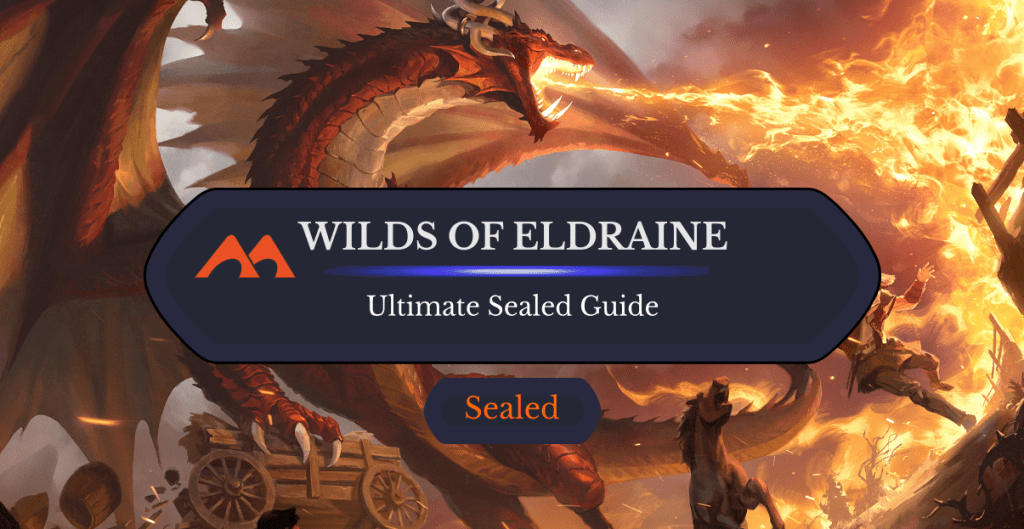
Realm-Scorcher Hellkite | Illustration by Billy Christian
Greetings planeswalkers! Here’s another Sealed guide for you, just in time for Wilds of Eldraine. This guide covers the set’s mechanics, archetypes, top commons, bombs and more. It also goes hand-in-hand with the site's Limited Set Review!
Let’s begin!
Mechanics
Roles

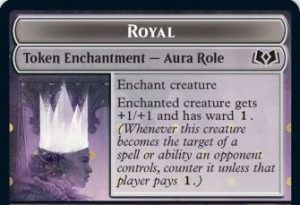
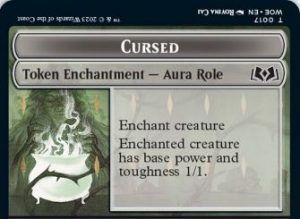
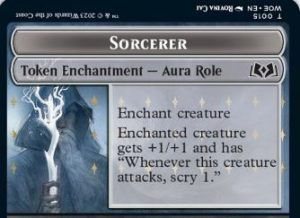

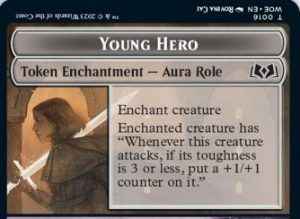

Roles are a new kind of token with six different variations, all of which are auras that enchant creatures. The six roles are:
- Cursed — Enchanted creature has base power and toughness 1/1.
- Monster — Enchanted creature gets +1/+1 and has trample.
- Royal — Enchanted creature gets +1/+1 and has ward .
- Sorcerer — Enchanted creature gets +1/+1 and has, “Whenever this creature attacks, scry 1.”
- Wicked — Enchanted creature gets +1/+1 and, “When this Aura is put into a graveyard from the battlefield, each opponent loses 1 life.”
- Young Hero — Enchanted creature has, “Whenever this creature attacks, if its toughness is 3 or less, put a +1/+1 counter on it.”
Most roles are simple auras that give +1/+1 and another bonus like trample or ward. Cursed is the notable exception, and it’s the only role you’ll want to put on your opponent’s creatures.
Creatures can only have one role controlled by the same player attached to it. If a creature ever has more than one role on it, it keeps the latest one and the others go to the graveyard (and then cease to exist because they’re tokens). Some important implications:
- You can’t stack roles (even differently named ones) on the same creature to make them better in combat.
- You can’t free your creature from an opponent’s Cursed role with a role of your own.
- You can free your creature from your own Cursed role by giving them a new one (i.e., Cursed Courtier).
Roles appear in all colors, though slightly more in white. If you’re curious, here’s which roles each color creates:
- White (Royal, Young Hero, Sorcerer, Cursed via Cursed Courtier)
- Blue (Cursed, Sorcerer)
- Black (Wicked, Cursed via Spiteful Hexmage)
- Red (Young Hero, Wicked, Monster)
- Green (Monster, Royal)
Bargain
Bargain is a new mechanic that lets you sacrifice an artifact, enchantment, or token for extra oomph on certain spells. Bargain is featured on creatures, instants, and sorceries. In all cases, you must sacrifice your artifact/enchantment/token as an additional cost when you play the spell. Bargain appears in all colors, though a bit more in green.
One thing that sets bargain apart from similar mechanics is that you can’t sacrifice (nontoken) creatures as a cost. You’ll need both bargain cards and somewhat specific fodder for them to consistently sacrifice. Some ideal objects to sacrifice are:
- Food tokens
- Treasure tokens
- Role tokens
- 1/1 creature tokens (especially Rats)
- Hopeful Vigil and Hopeless Nightmare
Bargain is a useful all-around mechanic, and I’d expect most decks to play a couple of bargain spells.
Celebration
The last new mechanic is celebration, a static ability that cares if “two or more nonland permanents entered the battlefield under your control this turn”. Celebration is an aggressive mechanic that appears on only white and red cards. Most celebration abilities make your creature(s) more effective in combat once achieved.
You can trigger celebration in a couple of different ways:
- The most obvious way is just to play two creatures in one turn, especially when one of those creatures is Ash, Party Crasher.
- Another way is to use ETB creatures that create any kind of token. Cards like Charmed Clothier, Edgewall Pack, Merry Bards, and Redcap Thief all have the stealth text “ETB: you have celebration this turn”.
- Treasure makers like Grabby Giant and Collector's Vault can get you halfway towards celebration while partially funding your 2nd permanent.
Adventure
Adventure is a returning mechanic that we haven’t seen in Standard since Throne of Eldraine, the last Eldraine set. Adventures are essentially creatures stapled to instants/sorceries, but with a twist: if you cast the instant/sorcery mode, you can exile the creature and play it from exile! It’s hard to get card advantage this free, so it should come as no surprise that adventures were amazing in Throne of Eldraine. The mechanic’s first outing spawned Constructed all-stars like Bonecrusher Giant, Brazen Borrower, and was great in Limited.
This go-around, adventures still seem strong but appear a bit tuned down. A key change seems to be in how adventures are designed: many adventures in this set have an awkward flow to them compared to Throne of Eldraine. Consider Bonecrusher Giant vs Heartflame Duelist: turn 2 Stomp, turn 3 Bonecrusher Giant is a natural curve, but Heartflame Duelist forces you to play off curve with its body to get value. You can see this same pattern on other cards: Pollen-Shield Hare, Elusive Otter, and Questing Druid all have creature sides that want to be played early and instant/sorcery modes that work best with setup.
This by no means applies to all adventures, as cards like Devouring Sugarmaw, Gumdrop Poisoner, and Decadent Dragon are easy P1P1s that flow perfectly. Another change to adventures from Throne of Eldraine is that adventures aren’t a true draft archetype in this set. Rather, they provide support/mana sinks for the set’s color pairs. Adventures appear in each color, but are rare in white and most common in blue/red.
Food
Food is another returning feature from Throne of Eldraine, though we’ve seen plenty of it since. Wilds of Eldraine shakes up the recipe with bargain and powerful Food payoffs like Tough Cookie and Welcome to Sweettooth. As you can see from Greta, Sweettooth Scourge, food is Golgari ’s archetype focus in Draft.
Archetypes
Color Pairs
As with most sets, Wilds of Eldraine has 10 draft archetypes, and each corresponds to a 2-color pair and feature their own signpost creature. The signposts in Wilds of Eldraine are legendary creatures and are flavored around popular fairy tales. Here’s all ten plus the fairy tale they are based on:
- Azorius : Tapping opponents' creatures (“The Snow Queen”)
- Dimir Faerie control (“Sleeping Beauty”)
- Rakdos : Rat token aggro (“The Pied Piper of Hamelin”)
- Gruul : Ferocious (“Ruby and the Wolf” or “Little Red Riding Hood”)
- Selesnya : Enchanted creatures (“Beauty and the Beast”)
- Orzhov : Bargain and sacrifice (“Pale as Snow” or “Snow White”)
- Izzet : Instants and sorceries (“The Sorcerer's Apprentice”)
- Golgari : Food (“Greta the Witch Hunter” or “Hansel and Gretel”)
- Boros : Celebration aggro (“Cinderella”)
- Simic : Big spells (“Jack and the Beanstalk”)
Before we cover the archetypes individually, there’s some overlap/competition between the archetypes worth discussing.
Gruul’s quest to get 4 power can be aided by many of the green support cards that Selesnya wants. Ferocious Werefox is an example of a card that both decks desire.
Selesnya and Golgari are both great at enabling bargain cards like Hamlet Glutton.
The rat cards that Rakdos wants are some of the best ways to trigger celebration for Boros. They also mean that Rakdos can get good use out of celebration creatures too.
Adventure faeries like Picklock Prankster and Obyra's Attendants suit both Izzet spells and Dimir faeries well.
Simic ramp lacks much direct overlap with other archetypes, but there’s enough good fixing in this set for it to splash whatever powerful cards it wants (more on this later).
Azorius Freeze
Sharae of Numbing Depths shows off Azorius’s focus on tapping creatures for profit. Ultimately, Azorius is a powerful but narrow archetype with only six dedicated payoff cards (two of which are rare/mythic). All of them except for Solitary Sanctuary are playable with no other tap cards.
Azorius’s best non-rare enablers are Frostbridge Guard, Plunge into Winter, Succumb to the Cold, and Icewrought Sentry (which is also a payoff). If you’re lucky enough to open Hylda's Crown of Winter and Hylda of the Icy Crown, you must play this archetype at the prerelease!
Dimir Faeries

Obyra, Dreaming Duelist headlines a Dimir strategy that’s one part faerie tribal, one part Dimir flash/control. This deck harkens back to Lorwyn and has the same penchant for cheap fliers, disruption, and keeping your opponent guessing.
Barrow Naughty, Spell Stutter, and Faerie Fencing are some of the payoffs you can expect. Spell Stutter seems particularly well positioned against bargain and adventures.
Rakdos Rats
Totentanz, Swarm Piper has friends in low places, and it’s more than willing to introduce them to your opponent. Rakdos is an aggressive strategy that goes wide and makes strong use of bargain cards and sacrifice effects.
Rat tokens notably can’t block, so having ways to get value out of them is important. You can leverage your Rats with bargain, plain sacrifice (i.e. Lord Skitter's Butcher), or just swinging out with Gnawing Crescendo. Voracious Vermin and Edgewall Pack are important commons for consistent Rat generation. Rakdos also has strong rare payoffs like Lord Skitter, Sewer King and Song of Totentanz, if you’re lucky enough to open/draft them.
Gruul Ferocious
Ruby, Daring Tracker is a solid mana dork that highlights Gruul’s penchant for 4+ power creatures. There aren’t too many other payoffs (just Boundary Lands Ranger, Picnic Ruiner, and Territorial Witchstalker), but it’s a straightforward deck that hits hard and fast. Minecart Daredevil, Grabby Giant, Ferocious Werefox, and Verdant Outrider are some reliable commons for enabling this theme.
Selesnya Auras
Syr Armont, the Redeemer is a solid signpost that plays well with Selesnya’s larger aura theme. This is a straightforward aggro deck that wants to curve out and suit its creatures up with Royal and Monster roles. Some awesome payoff cards for this archetype include Archon of the Wild Rose, Tanglespan Lookout, and Yenna, Redtooth Regent. Key commons to look out for are Besotted Knight, Curse of the Werefox, Ferocious Werefox, and Redtooth Genealogist.
Orzhov Sacrifice
Neva, Stalked by Nightmares is a great gravedigger that also grows and scries when you sacrifice enchantments. This is a tipoff that Orzhov is the best home for similar cards like Knight of Doves, Ashiok's Reaper, and Savior of the Sleeping. Hopeful Vigil and Hopeless Nightmare are top tier commons here for efficient sacrificing.
Round out the rest of your deck with cheap roles and bargain spells like Kellan's Lightblades and Rowan's Grim Search for extra sac synergy.
Izzet Spells
Johann, Apprentice Sorcerer is my kind of card; a durdly 2/5 that wants to do nothing but sit around casting spells all day! But really, its and Izzet’s larger theme should come as no surprise. You’ll be casting and drafting spells at a higher clip than other decks, and you can supplement your deck with adventures to avoid playing too few creatures. Cards like Aquatic Alchemist, Frantic Firebolt, and Unruly Catapult are obvious fits for Izzet.
Izzet also has access to great bargain spells like Johann's Stopgap, Tenacious Tomeseeker, and Torch the Tower, but it struggles a bit with providing fodder. Treasure makers like Grabby Giant and Redcap Thief are probably your best bet for enabling bargains.
Golgari Food
Greta, Sweettooth Scourge is a mouthful of a card, both to say and to deal with for your opponent. It’s an efficient and versatile threat that even comes with a free Food to use. Most of the other food payoffs seem pretty good, though Night of the Sweets' Revenge is a card I’m not sure on. Prioritize solid commons like Sweettooth Witch, Hollow Scavenger, and Return from the Wilds to generate Food tokens while developing your board.
Boros Celebration
Ash, Party Crasher is crashing the party for sure, and it might crash your opponent’s face too. I’m not usually a big fan of in Limited, but I must admit that celebration seems pretty powerful. Building a lean deck with lots of cheap permanents seems ideal to leverage the mechanic. Throw in a couple of more expensive token makers to keep the celebration going. Armory Mice, Tuinvale Guide, Grand Ball Guest, and Ratcatcher Trainee should be bread and butter commons for .
Simic Ramp
Troyan, Gutsy Explorer brings us a ramp strategy straight from the streets of Ravnica. It gives you lots of mana to spend on certain spells, and also loots in case you find yourself flooded. Its “mana value 5 or greater” subtheme is shared by a handful of cards, all of which would be solid inclusions. I particularly like Skybeast Tracker here because it blocks every common flier in the set and generates free Food to drag out games.
Top Commons
Predicting top commons is always a fun thing to do for new Limited sets. I’ll give it my best guess with five commons for each color, with some commentary on why I picked each one.
White
#1. Cooped Up
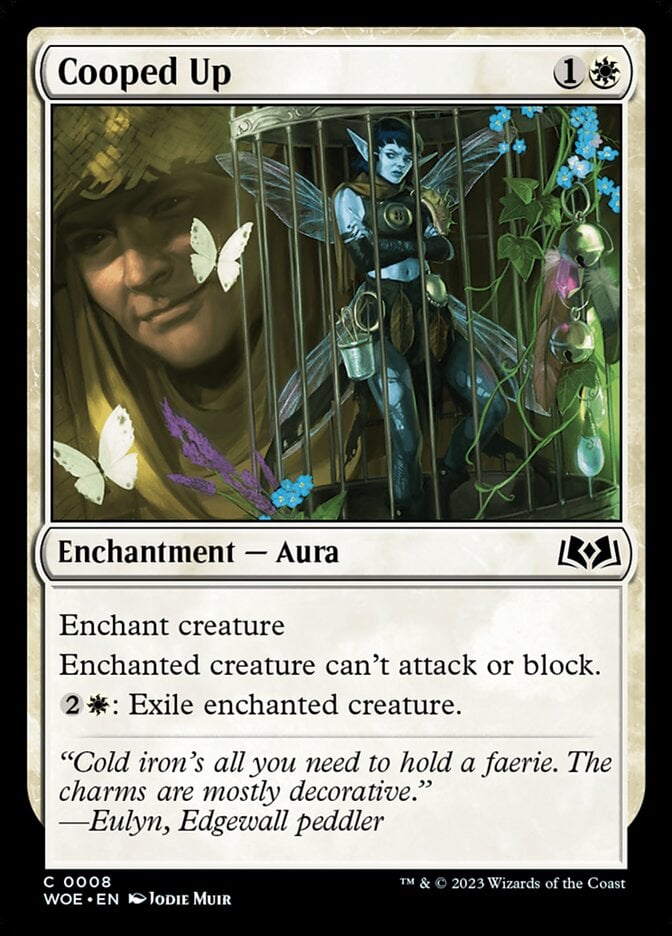
Cooped Up is an incredible Choking Restraints variant, as the double mana discount should make a huge difference. Being able to exile the creature on demand can mitigate usual Pacifism woes like flicker/enchantment destruction. Doing so also triggers cards that care about enchantments being sacrificed!
#2. Hopeful Vigil
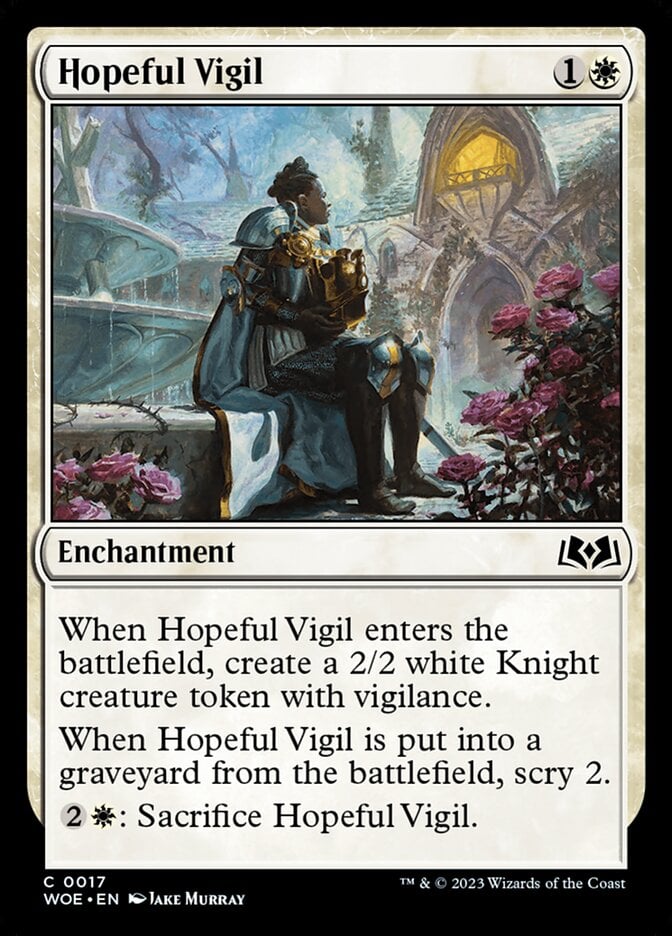
Even with no synergy, Hopeful Vigil is a 2/2 vigilance creature for that lets you scry 2 later. But synergy is precisely why I have this card at the #2 slot, because it’s a perfect card for bargain, celebration, and enchantment synergy!
#3. Rimefur Reindeer
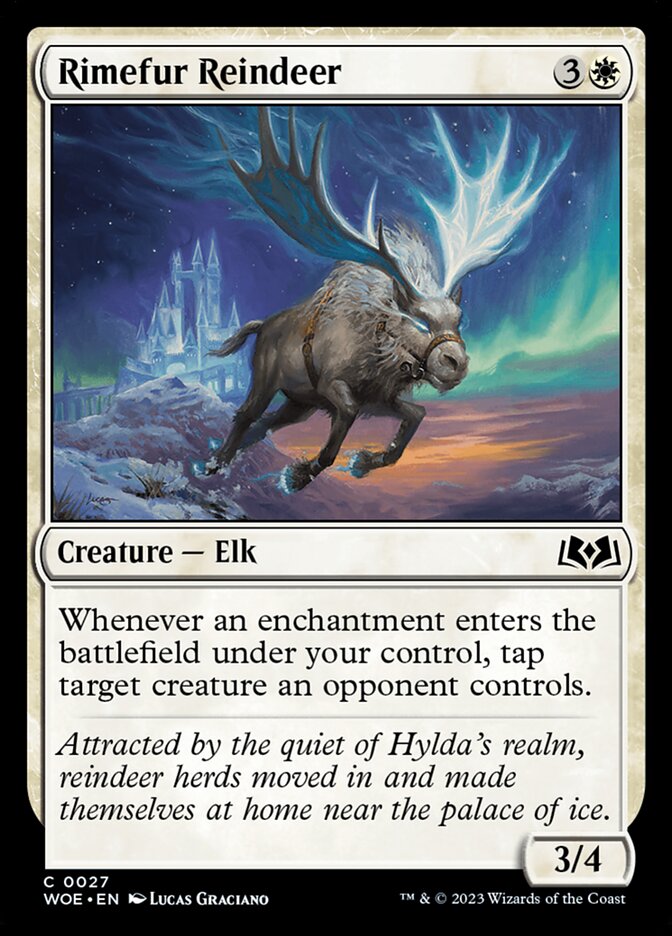
3/4 for isn’t a bad statline, so I’m a bit surprised to see such a strong ability on a creature as large as Rimefur Reindeer. Trying to stabilize against this card seems kind of gross, as every role is a tap, and Cooped Up gets rid of two blockers the turn you play it.
#4. Archon’s Glory

Archon's Glory is really efficient when bargained, and it’s passable when used plainly. I’m rating this highly because this is white’s best combat trick, and white seems proactive enough to use it well.
#5. Frostbridge Guard
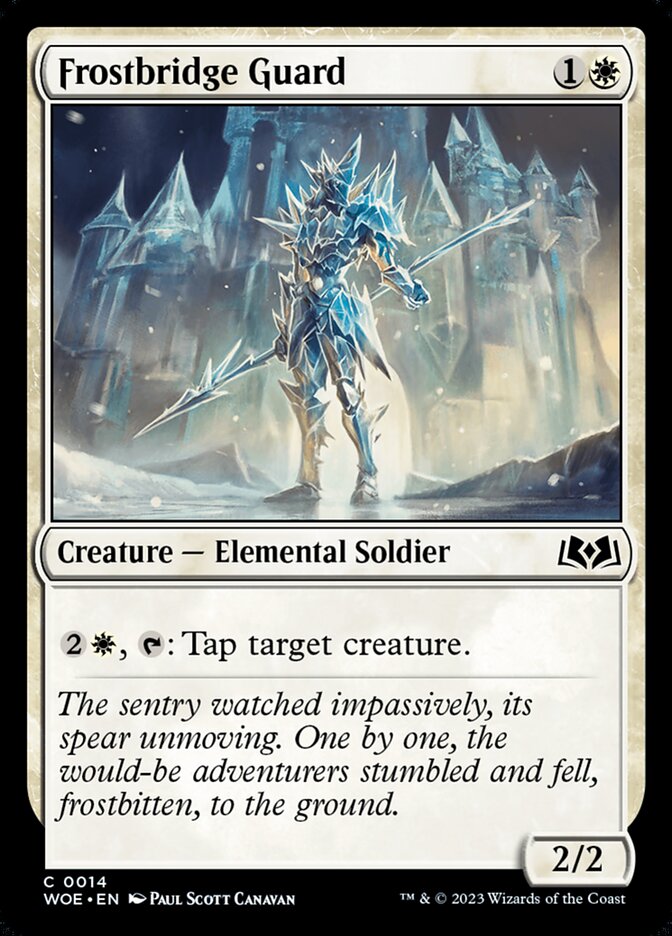
Bears that scale well into the late game are nice, and a rare thing to see at common. Frostbridge Guard seems like a solid all-around playable that does best in .
Blue
#1. Quick Study
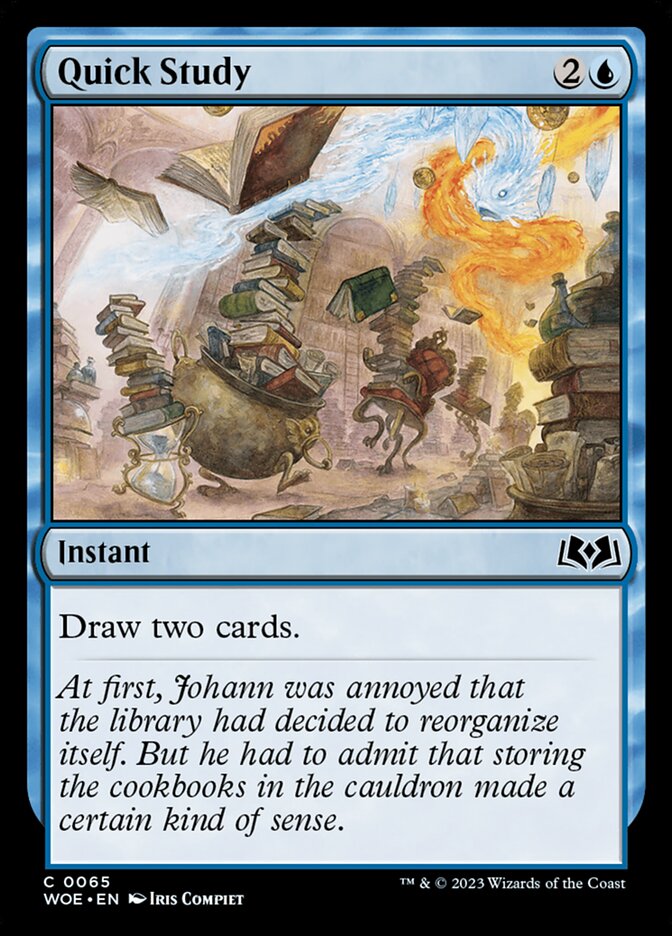
Divination and Inspiration, eat your hearts out! Quick Study is a strong card draw spell that also lets you represent other instants like Spell Stutter. Every blue deck wants to play a couple of copies if possible.
#2. Vantress Transmuter

Vantress Transmuter is a great 2-for-1 that nerfs a creature and then provides a solid body. Whether you should be choosey with the Cursed role depends on how urgently you need the 3/4 body to block. Waiting for Hamlet Glutton to show up seems rewarding if you can manage it.
#3. Spell Stutter
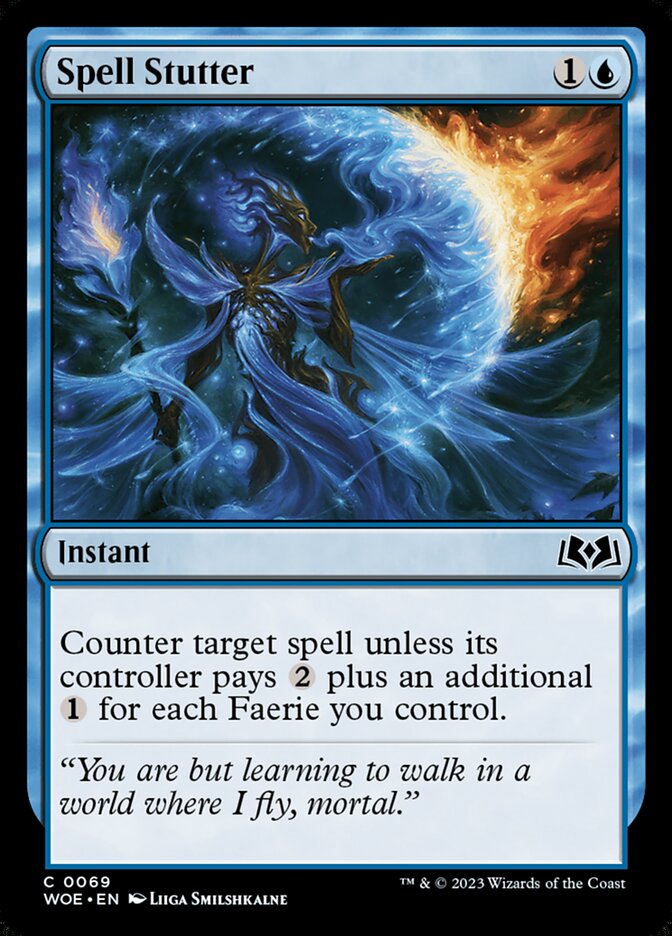
Quench isn’t too bad in a set with adventures and bargain, but that’s just the floor for Spell Stutter. Getting this to be Mana Leak isn’t hard, and Mana Leak has been too good to print for almost a decade now!
#4. Obyra’s Attendants

A nice adventure that’s one part combat trick, one part decent flier. Whether you wait to get value out of Obyra's Attendants is a skill tester because -4/-0 isn’t always easy to set up wins with. Most decks are interested in this either way.
#5. Beluna’s Gatekeeper
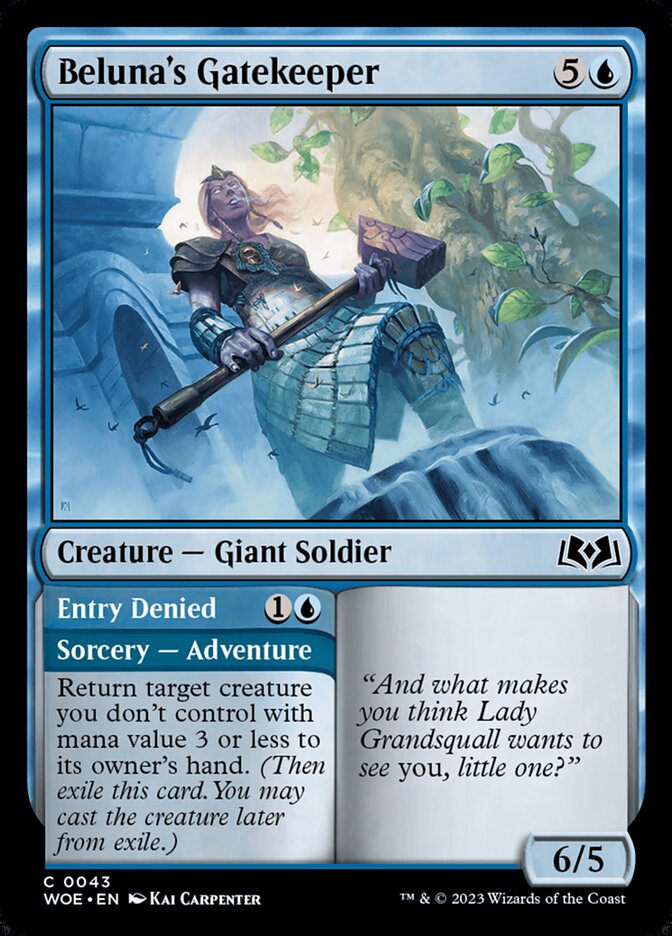
Another adventure that should fit fine in most decks. Beluna's Gatekeeper seems best in ramp, as the bounce spell half is pretty bad on its own.
Black
#1. Candy Grapple

Candy Grapple isn’t only black’s best common, but also my pick for the best common in the set! -3/-3 for at instant would already have been a great rate, but bargain for -5/-5 just puts this completely over the top. A good heuristic for judging how good rares/uncommons are is “Would I take this over Candy Grapple?”
#2. Barrow Naughty
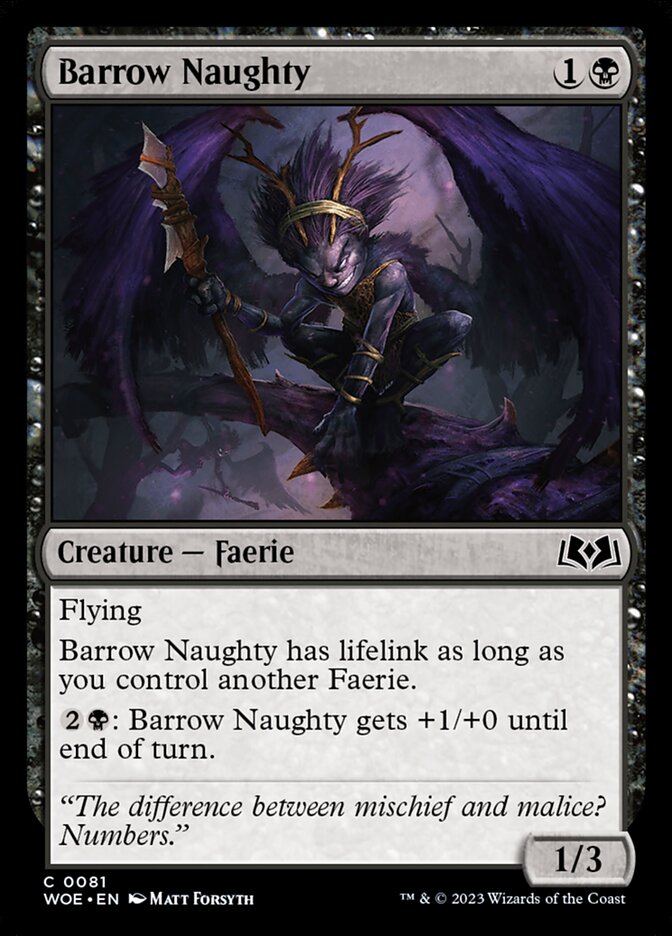
The rate here is pretty strong for a common, although part of it is tied up into having another faerie. Even without one, Barrow Naughty isn’t an unplayable rate, so I expect decent things from it.
#3. Fell Horseman
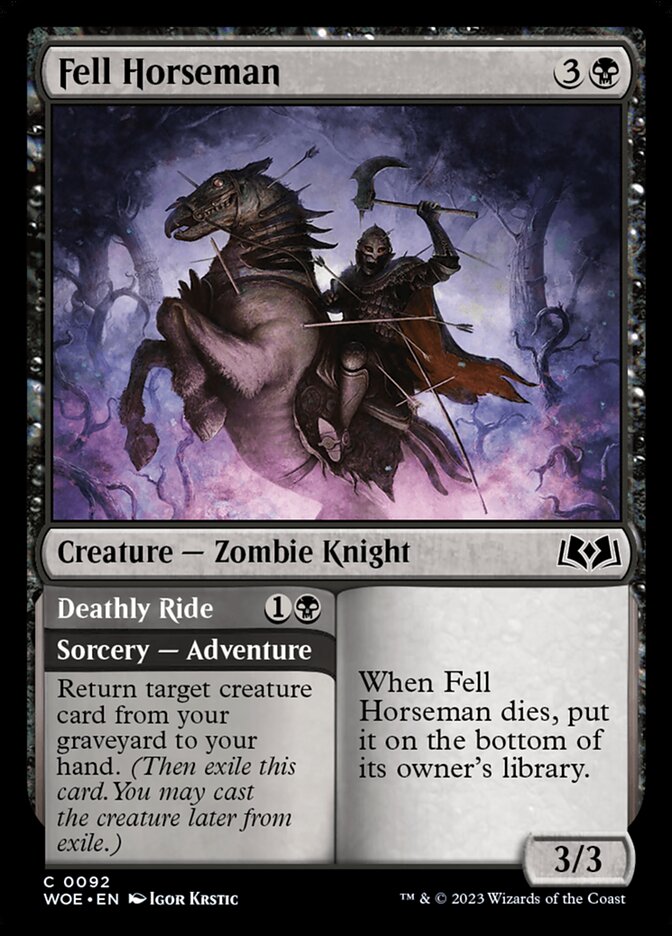
This is a slow but solid value creature that most decks should enjoy. Fell Horseman can’t loop with itself due to its “bottom of the library” clause, so don’t prioritize a second copy.
#4. Feed the Cauldron
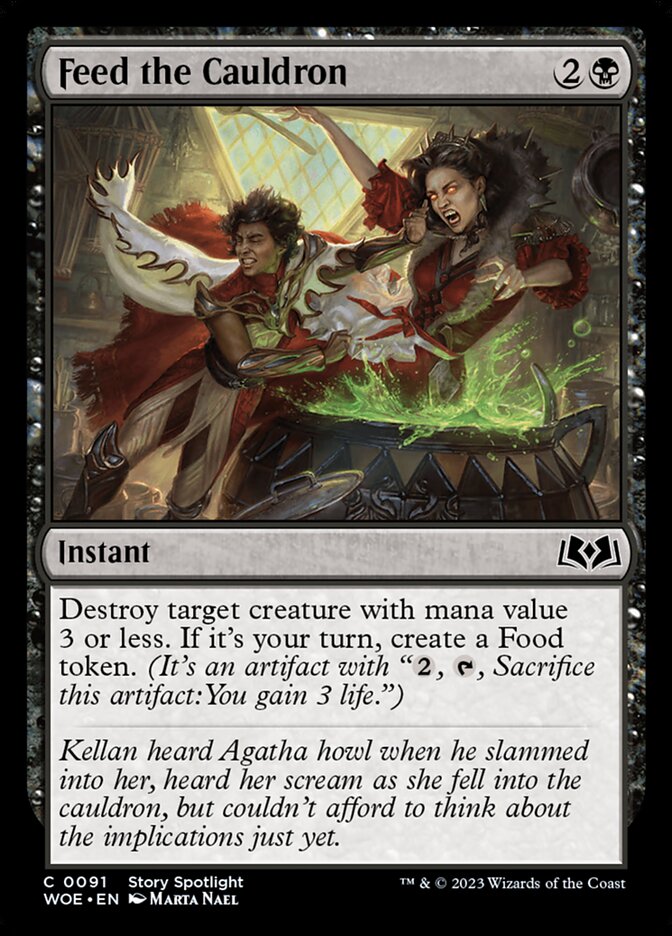
It's not the best or most broad removal spell, but “kill your 3-drop make a Food token” seems like a good exchange to me. Good bargain enablers like Feed the Cauldron are worth keeping an eye on.
#5. Stingblade Assassin
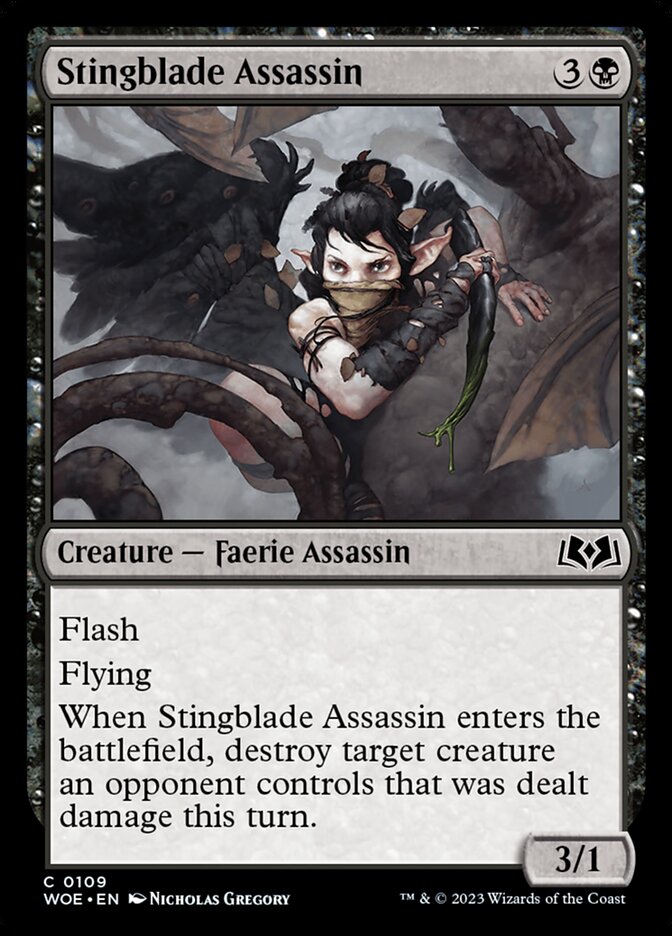
Manticore is a much more efficient card with +1 power, and this has nice synergy with rats/faeries too. My reservation with Stingblade Assassin is that it dies to cards like Rat Out, Flick a Coin, and Frolicking Familiar, so it could be a liability in some matchups.
Red
#1. Torch the Tower
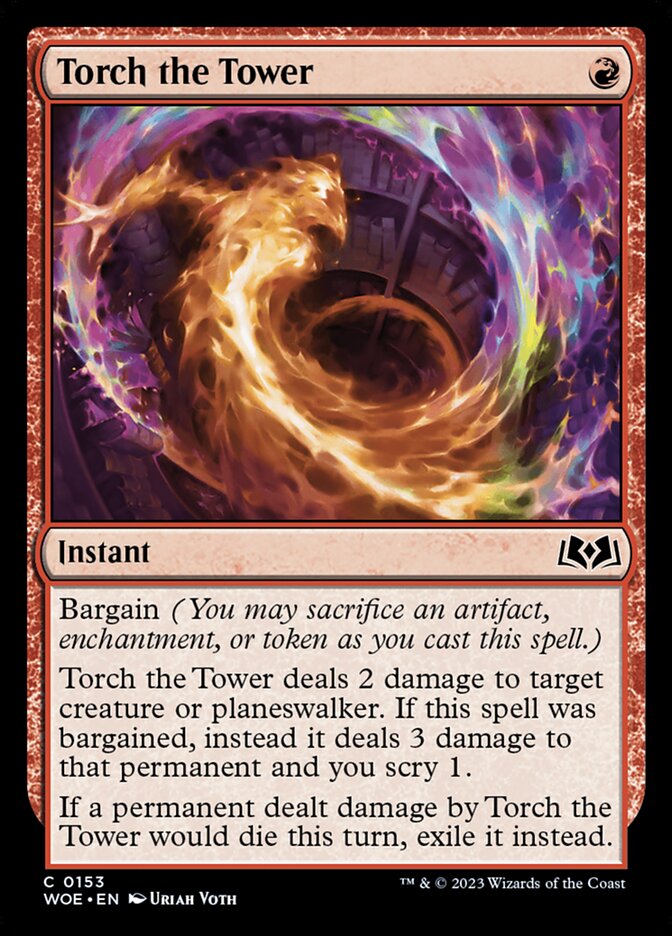
It’s not quite as good as Candy Grapple, but Torch the Tower is still an efficient removal spell with bargain upside. The exile rider hoses cards like Protective Parents, Mintstrosity, and Tangled Colony too!
#2. Grand Ball Guest

Bears with upside are rare in red, and Grand Ball Guest has some pretty good upside. An excellent aggro card in a generally aggressive color.
#3. Ratcatcher Trainee
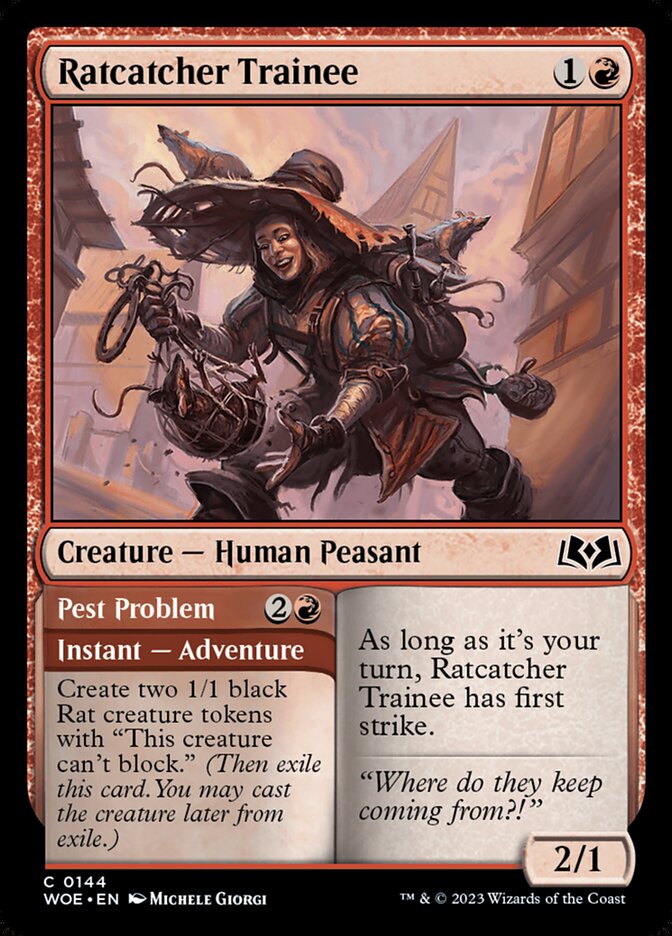
A solid 2-drop that also has a value/celebration mode for later in the game. Don’t be afraid to skip value to curve out because the extra damage from playing Ratcatcher Trainee can be more valuable than two overcosted rats.
#4. Minecart Daredevil
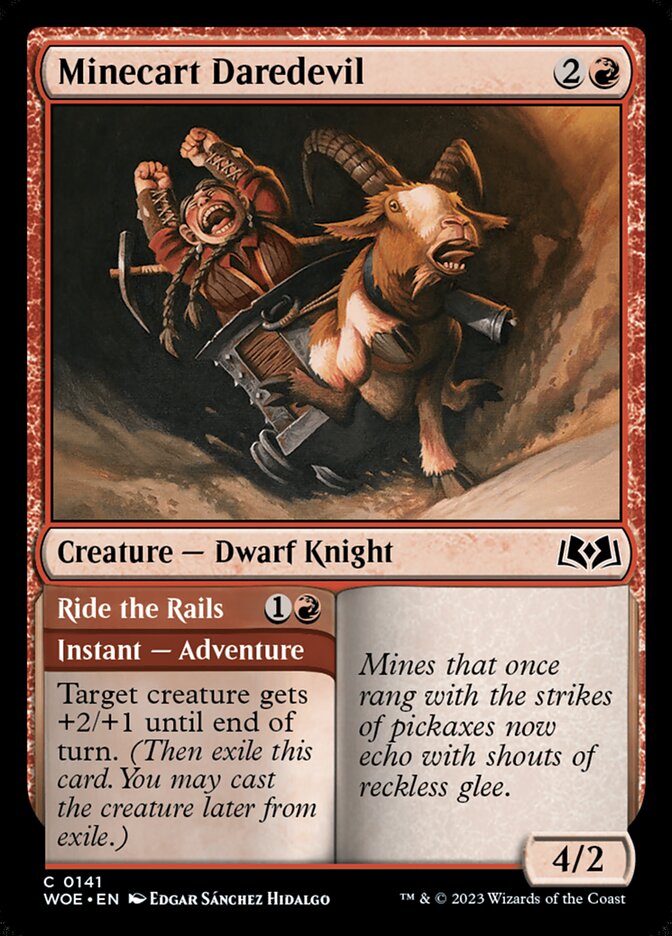
A good adventure that I expect to overperform, despite an underwhelming stat line. The trick is particularly good with rats and other cheap creatures. Get your Minecart Daredevil out on board quickly so that your opponent feels pressured to block into +2/+1.
#5. Grabby Giant
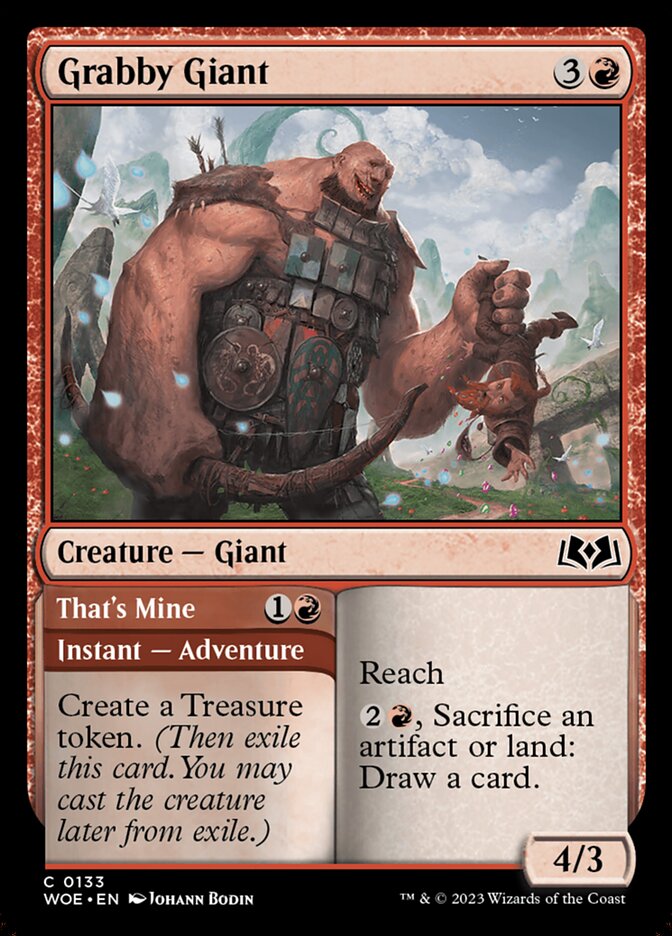
Grabby Giant is a remarkably flexible card that checks a number of boxes: it lets you splash and activate celebration easier, and it has 4 power for . It also blocks every common flier in the set, though it trades with a few of the bigger ones. It even has an anti-flood ability for very long games!
Green
#1. Rootrider Faun
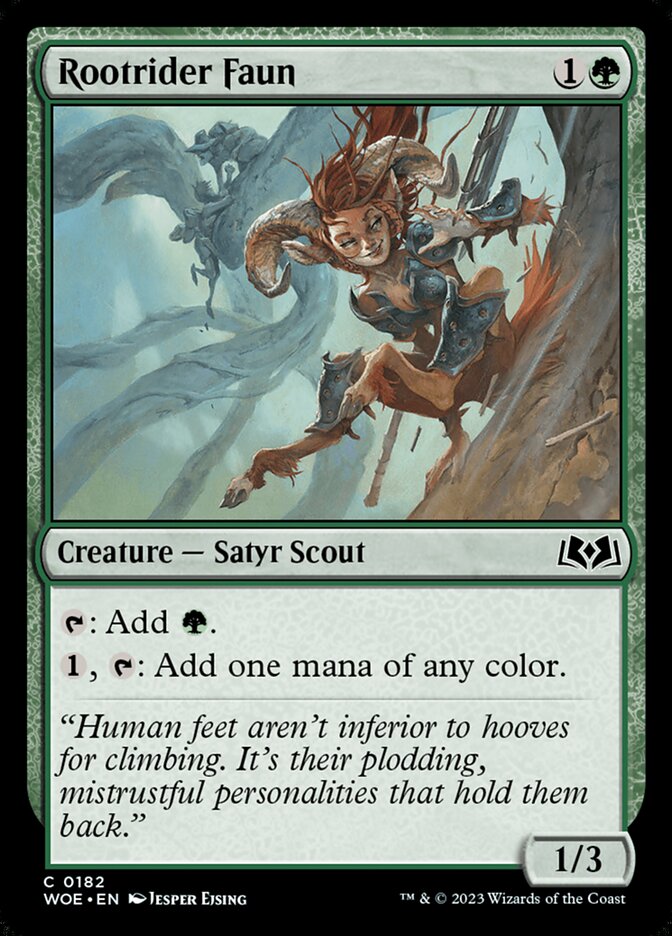
Druid of the Cowl now fixes your mana too if needed! Rootrider Faun is a great mana dork that every green deck should want.
#2. Hamlet Glutton
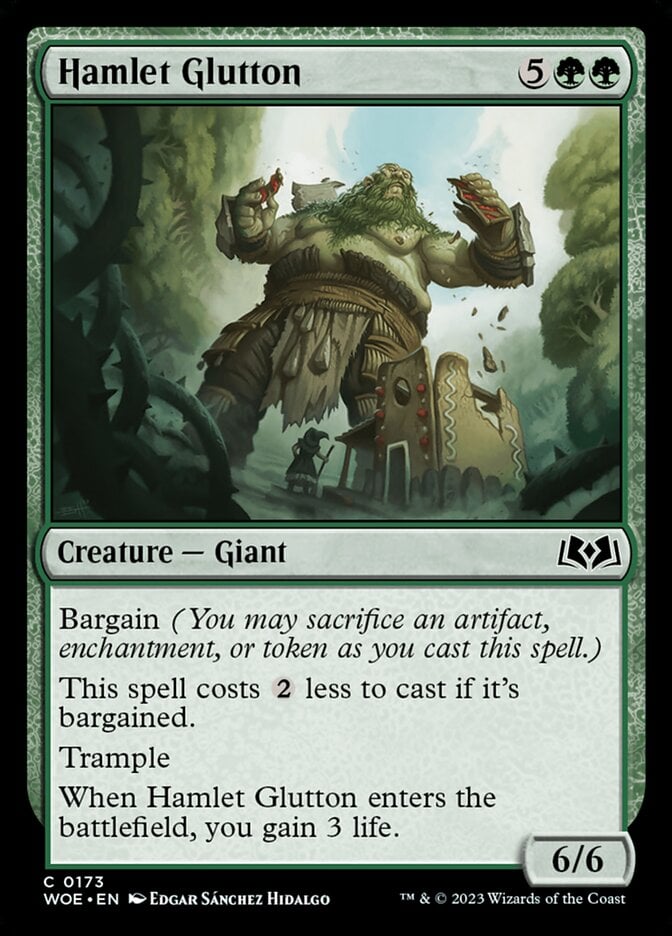
Best common fatty by a long shot, especially given how few other big creatures there are. The only reason I didn’t put this at #1 is that you must consistently bargain for it to be efficient. Countermagic also gives Hamlet Glutton a bad time.
#3. Return from the Wilds
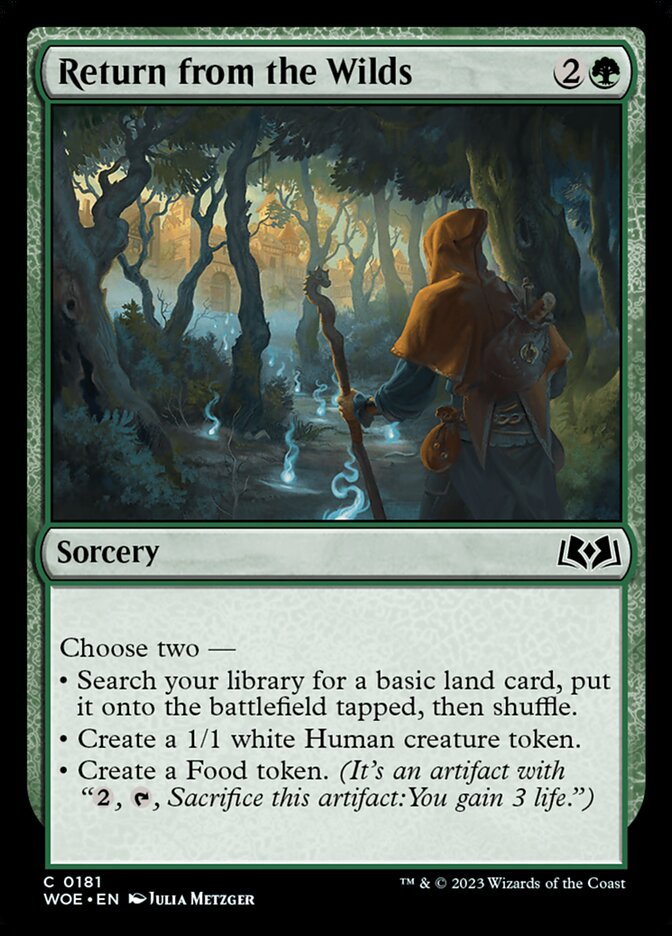
An Elvish Rejuvenator of sorts that can also make a Food if you’d prefer that. Return from the Wilds is great in any deck that isn’t low to the ground, especially if you are using it to splash.
#4. Curse of the Werefox
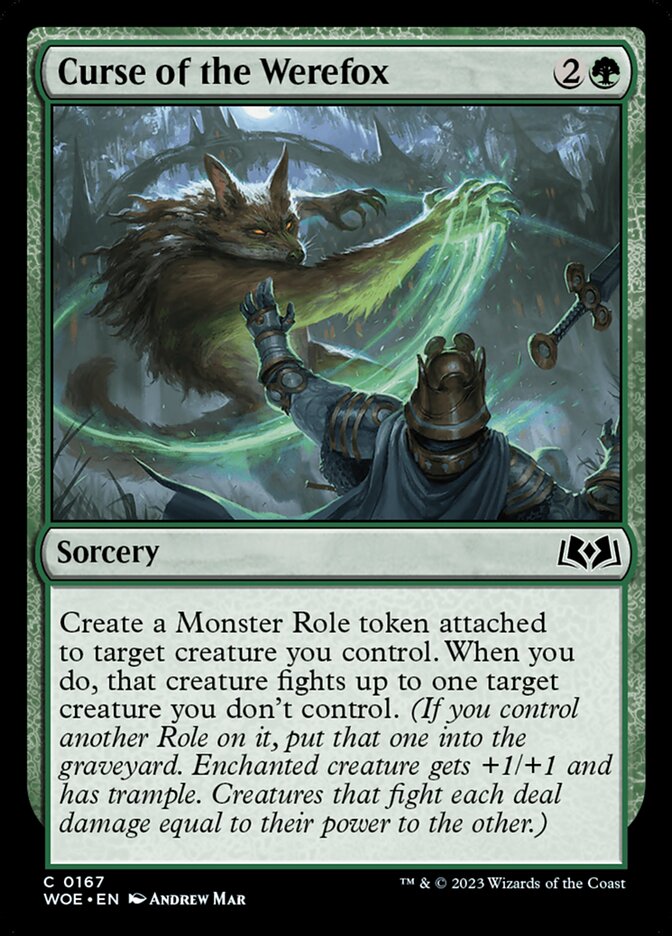
Strong Hunt the Weak variant that costs a bit less and enables enchantment/role synergies. It’s still clunky though, so watch out for combat tricks. It does help at least that the set’s two common bounce spells (Beluna's Gatekeeper and Johann's Stopgap) are both sorcery speed.
#5. Ferocious Werefox
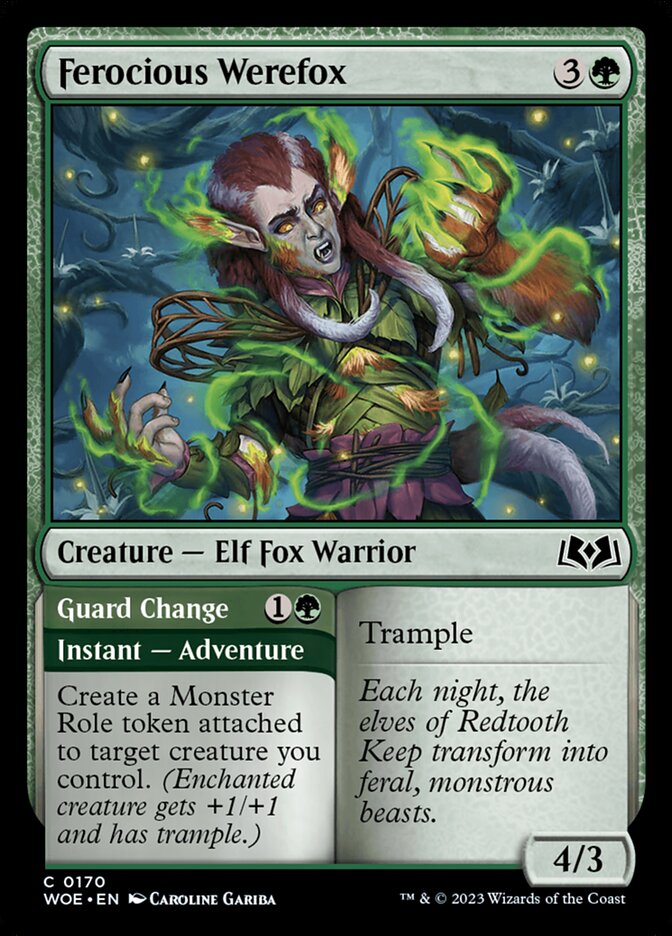
Not the most efficient creature or monster role, but the fact that you’re getting both should make up for it. Ferocious Werefox also has 4 power for all your RG payoffs.
Commons to avoid
While I don’t see anything truly unplayable, here are some cards I’d usually avoid:
Slumbering Keepguard

Slumbering Keepguard is a strange enchantment payoff that wants you to keep enchantments around rather than sacrifice them. It can get pretty large in theory, but to do so you’ll have to dump mana into it each turn (and it’s highly chumpable when you do). It also lives in fear of x/1 killers like Rat Out and Flick a Coin. Probably best in , but I doubt I’ll be playing it even there.
Freeze in Place
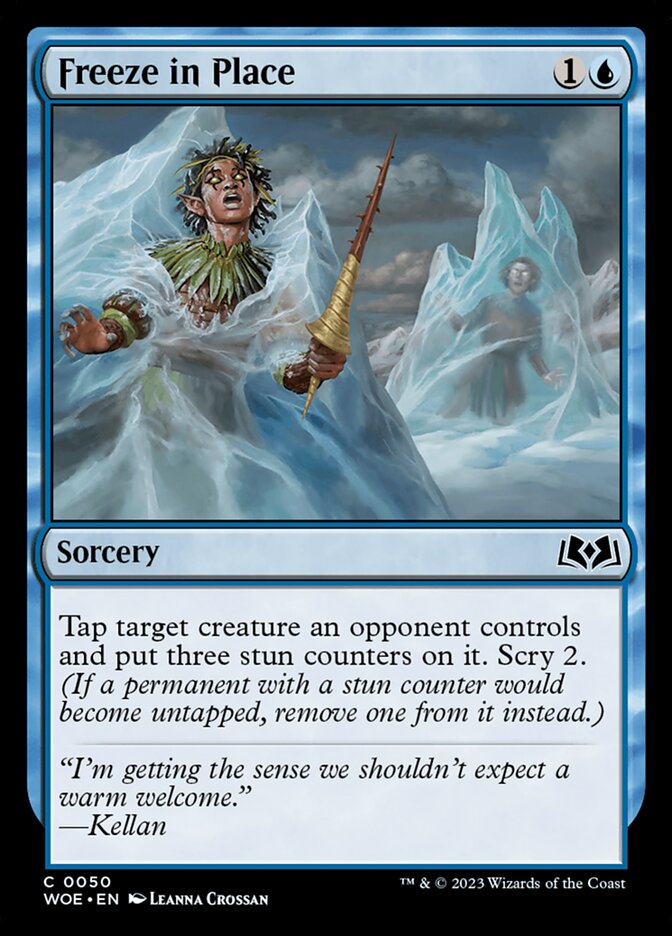
As an aggro card, Freeze in Place seems outclassed by Johann's Stopgap and Water Wings. As a Freeze enabler, you can do better. Not unplayable, but I’d be surprised if it impresses.
Misleading Motes
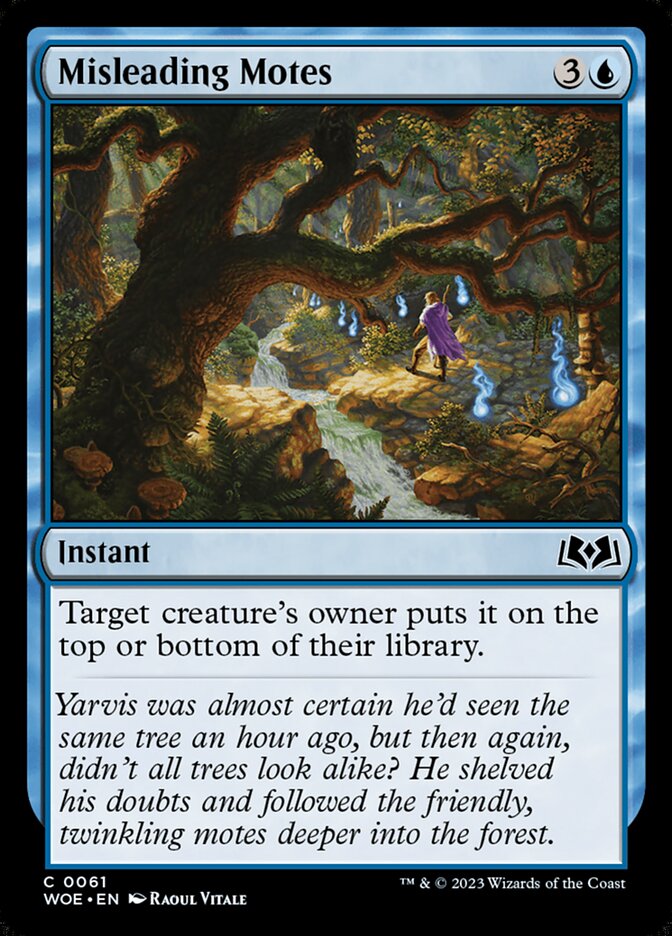
Nerfed Griptide in a set with so many better versions of other past commons is a strange sight. Misleading Motes is interaction for when you are down bad on interaction and just need something. Hamlet Glutton is probably the best thing you can hit with it.
Warehouse Tabby
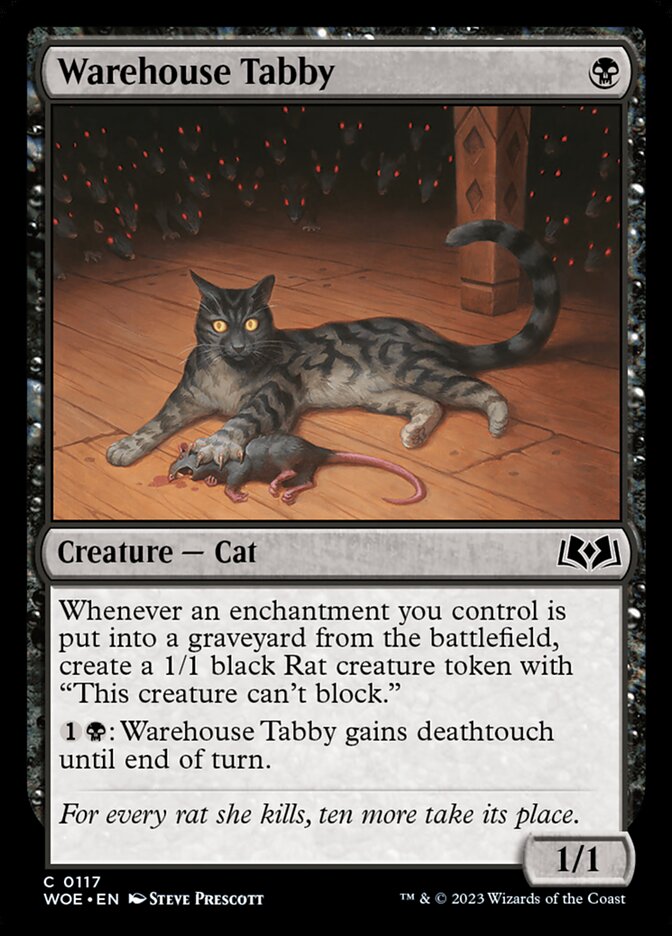
Strange card that is one part bad engine, one part bad Skittering Heartstopper. You can’t trade it off efficiently, but if you don’t trade it off, it’s usually not going to do much either. Even when you do trigger Warehouse Tabby a couple of times, all you’re getting are Rat tokens, and if you’re triggering this in the first place, you probably aren’t making the most out of those. The only good thing about this card is the art.
Bespoke Battlegarb

Equipment that doesn't give toughness is traditionally not great, as your 5/3 Grand Ball Guest is still going to trade with your opponent’s Mintstrosity. Ratcatcher Trainee is your best hope for Bespoke Battlegarb to do anything.
Harried Spearguard

Might be fine? I could just be a greedy control player at heart, but something about Harried Spearguard screams “virtual mulligan” to me.
Bestial Bloodline
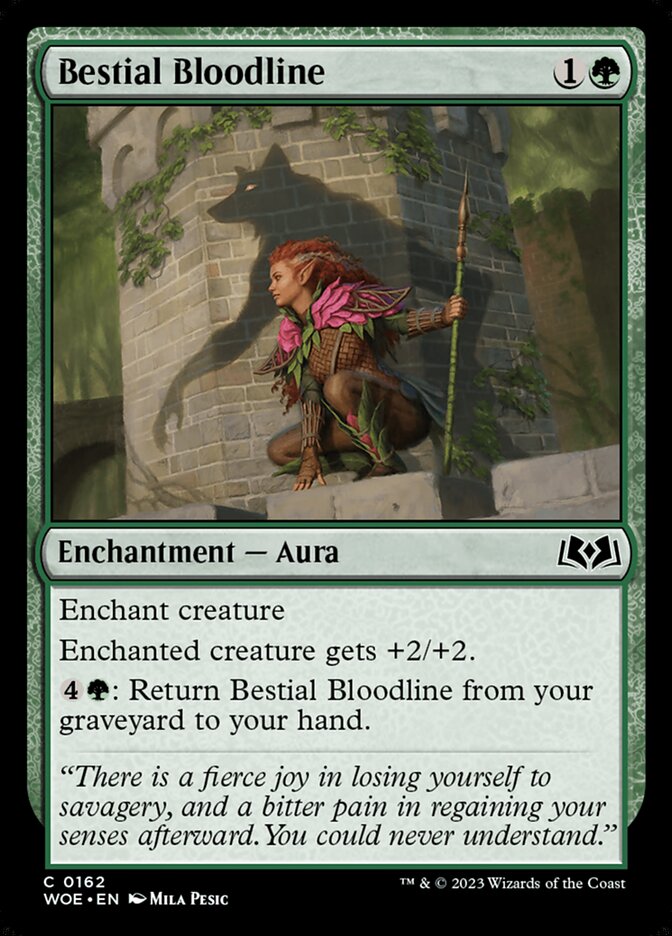
Knight's Pledge with bad upside is still too close to Knight's Pledge for me to want to play it. You can maybe make a case for it in , or alongside looting effects like Collector's Vault (as Vault + this = 2 mana Jayemdae Tome).
Toadstool Admirer
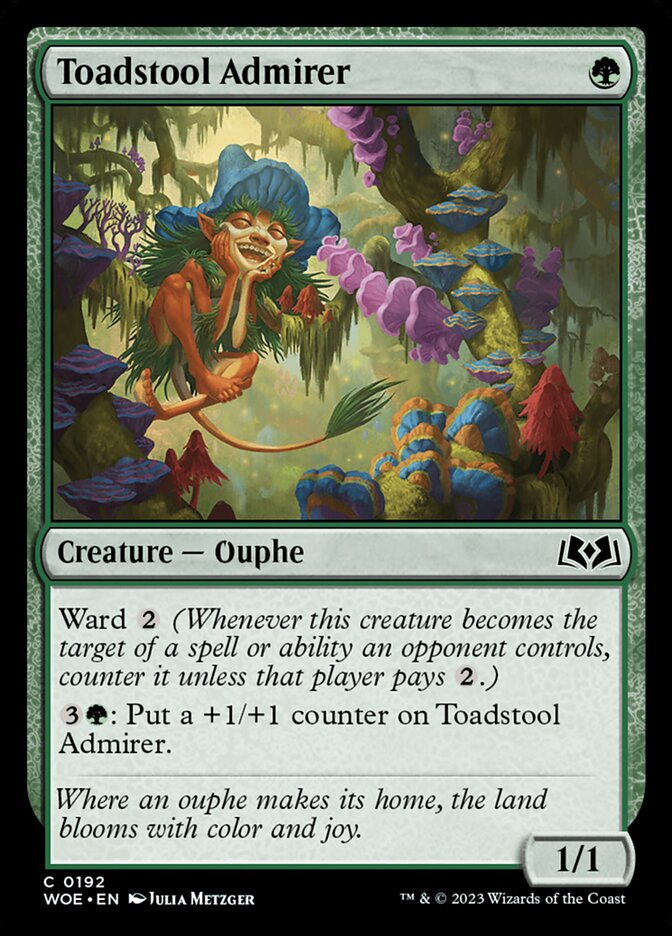
Jungle Delver is just too bad of a card to play these days, even with ward (2). Toadstool Admirer is another card that yells “virtual mulligan” at me.
Bombs
It’s important to know what cards to splash in Sealed! You wouldn’t want to be that person whose friends tease them about leaving some “unbeatable rare” in your sideboard, would you? Before we get to a list, a word on splashing in Wilds of Eldraine….
Splashing
Wilds of Eldraine has above average fixing compared to most sets. At common, your options to splash are:
Red
Grabby Giant, Flick a Coin, and Redcap Thief can let you play single pipped cards from another color, so long as you don’t use the Treasure early. You might see your opponent cast cards you’d never expect off these.
Green
Rootrider Faun and Return from the Wilds were mentioned as strong fixers earlier. Brave the Wilds is a fallback option as Lay of the Land + bargain upside.
Colorless
Prophetic Prism, Evolving Wilds, and Crystal Grotto are decent fixers that basically any deck can play. Prophetic Prism has a bit of extra value in this set as cantrip bargain fodder. Crystal Grotto excels when splashing adventures that you could otherwise play (picture a deck with Decadent Dragon, 8 Islands, 8 Mountains and 1 Crystal Grotto to occasionally cast the mode). The only other fixer is Scarecrow Guide, a mediocre 2-drop that I’d hope not to play if possible.
Mana Bases for Splashing
Try to hit 8 sources for each of your primary colors, and at least 3+ sources for whatever you splash. A common configuration in this set I’d expect would be 8 primary color basics, 7 of your other primary color basics, 1 Evolving Wilds, and 1 splashed basic. Expect to play 16-18 lands depending on your curve (you might be able to play 15 if you have several copies of Brave the Wilds and Rootrider Faun). Base decks that splash a bunch of colors need to make sure they have enough Forests to start each game with one (8+).
Cards to Splash
While not exhaustive, here’s a list of cards you might want to consider splashing when convenient:
Common
Cooped Up

Splashes better with basics than Treasure so that you can reactivate if needed.
Moment of Valor
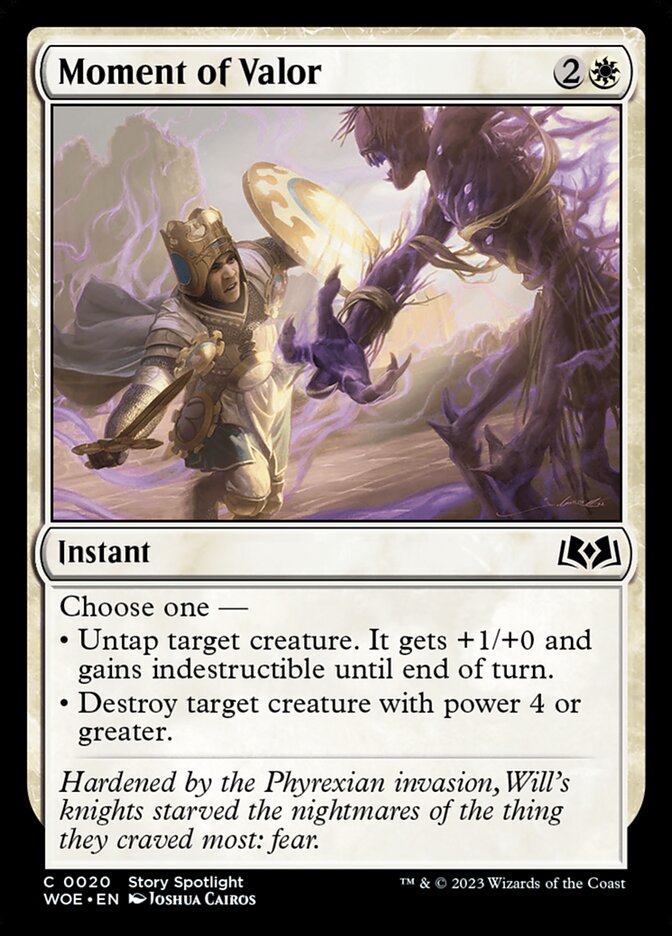
From the sideboard for large threats.
Candy Grapple

Uncommons
- Stroke of Midnight
- Woodland Acolyte
- Threadbind Clique
- Spellscorn Coven
- Korvold and the Noble Thief
- Stonesplitter Bolt
- Agatha's Champion
- Gingerbread Hunter
- Tanglespan Lookout (Only if you have enough roles/auras, of course)
- Neva, Stalked by Nightmares
- Johann, Apprentice Sorcerer
- Greta, Sweettooth Scourge
Rares
- Expel the Interlopers (Double white but extremely good if you can manage it.)
- Heartflame Duelist
- Regal Bunnicorn
- Spellbook Vendor
- Ingenious Prodigy
- Talion's Messenger
- Specter of Mortality (Double black but great if you can manage it.)
- Decadent Dragon
- Song of Totentanz
- Elvish Archivist
- Yenna, Redtooth Regent
- Faunsbane Troll
- The Goose Mother
Mythics
- Virtue of Loyalty (Double white but absurd; you should probably just force base white for this honestly.)
- Asinine Antics (Same as above but blue.)
- Virtue of Persistence (Same as above but black.)
- Realm-Scorcher Hellkite (Same as above but red.)
- Hylda of the Icy Crown (Only great if you can throw in a couple of ways to tap creatures, but completely absurd if you can trigger it just once.)
- Talion, the Kindly Lord (Name “3” or “4” if you’re unsure what to name, or just name whatever mana value/power lines up with an adventure your opponent has in exile.)
- Eriette of the Charmed Apple (Needs auras to be busted, but all it takes is a couple of Roles or Cooped Up for this to take over a game.)
Enchanting Tales (Bonus Sheet)
One last thing I have to mention is this set’s bonus sheet, Enchanting Tales. Each pack you open includes an enchantment with unique art from all sorts of past Magic sets. Like in past sets featuring this mechanic (i.e., Strixhaven, The Brothers’ War, and March of the Machine), you can play these cards in Sealed and pick them in Draft like any other card. While these 63 cards are interesting, I must say that they’re without a doubt the weakest we’ve seen of any Bonus sheet. There are even anime versions!
Bitterblossom and Defense of the Heart are the only busted cards on the bonus sheet. Dawn of Hope, Goblin Bombardment, and Grasp of Fate also seem strong.
Some other cards like Doubling Season and Vampiric Rites can be strong, but require specific decks. More often than not though, you open lots of unplayable trash like Blood Moon, Prismatic Omen, Rest in Peace, and Leyline of Sanctity. Stone unplayables seem to make up roughly half of the entire sheet!
Ten Steps for Sealed
- Open your pool and sort your cards by rarity/color.
- Note your bomb rares, multicolor cards, removal spells, and fixing.
- Assess which of your colors is the deepest after removing weak cards (like the ones I mentioned in “commons to avoid” above).
- Try to group your cards by function and micro synergies (i.e., tap payoffs + tappers, spells payoffs etc.)
- Keep the 10 2-color archetypes in mind because they’re a good road map for making your deck feel cohesive.
- Start laying out builds that play as many of your good cards, bombs, etc. as possible.
- You should have some fixing, so don’t be afraid to reach into other colors to identify bombs and removal spells that you want to play. The best commons to splash are removal spells, and the best rares are swingy, single-pip spells that don’t need to be cast early on.
- Iterate your deck over and over, trying to strike the perfect balance between mana curve, card advantage, bombs, removal, etc.
- Settle on a final product, and battle it out!
- And finally, don’t forget that you can use our Sealed pool generator to practice the set.
Wrap Up

Stroke of Midnight | Illustration by Julia Metzger
And that’s it for the guide! Thanks for reading, and I hope your prerelease(s) go well. I sincerely hope you enjoyed reading this as much as I enjoyed writing it.
Make sure to check out the Draftsim Discord and discuss your expectations and results from your sealed events!
Until next time, may you always open the best Sealed pool at your table!
Follow Draftsim for awesome articles and set updates:
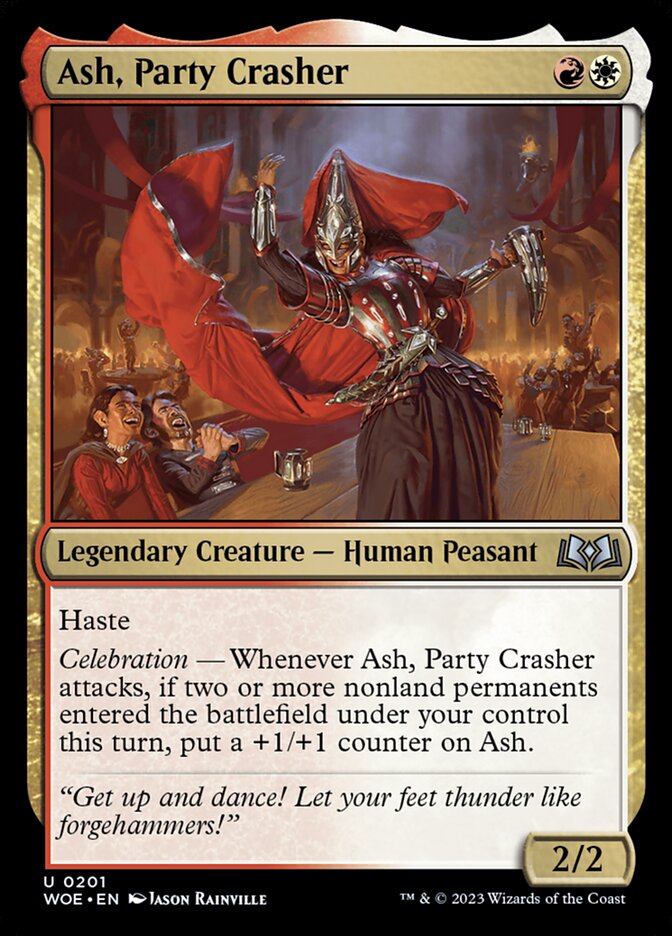
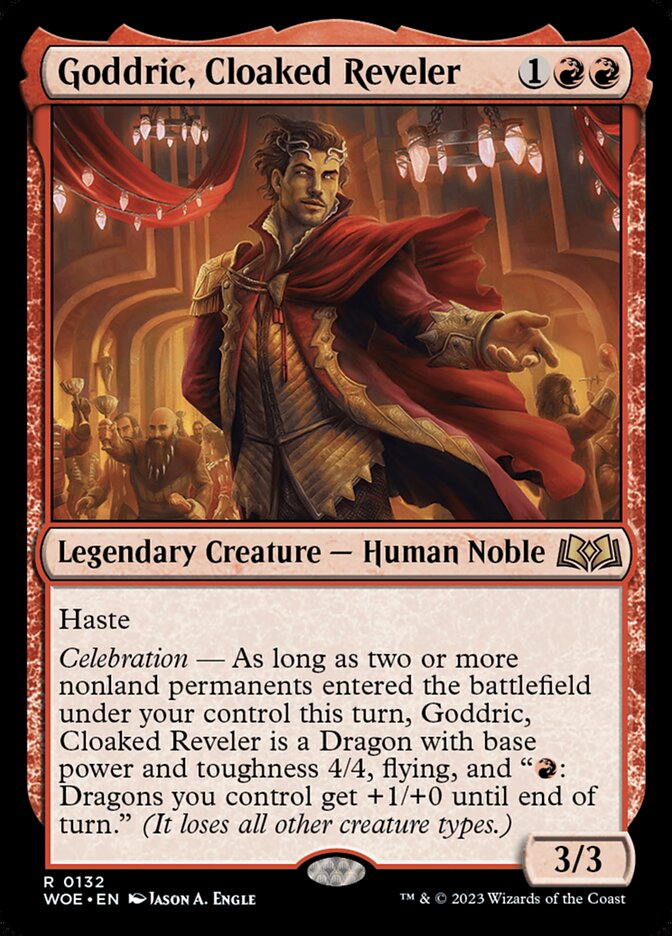
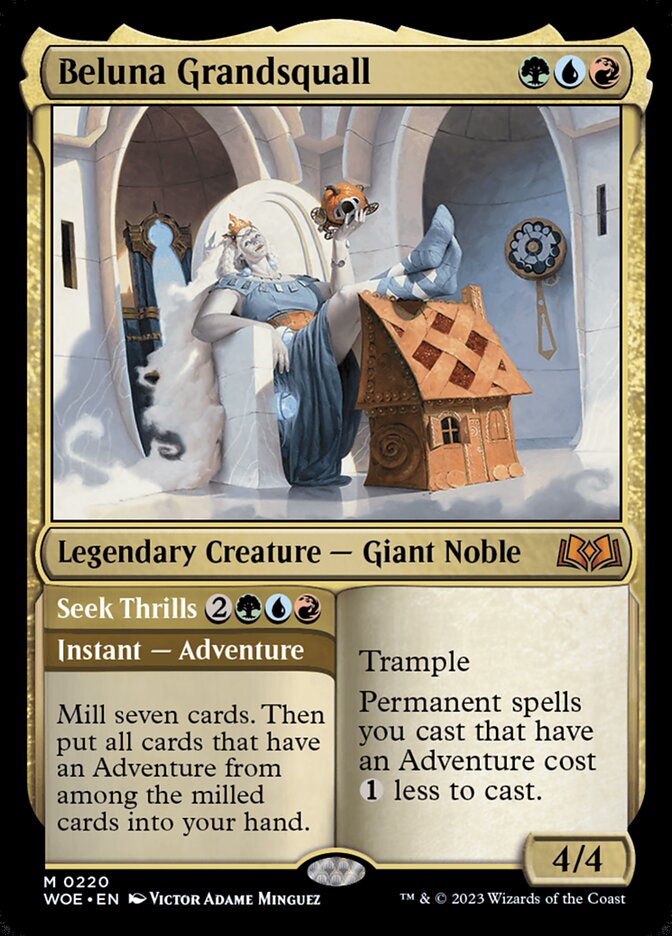
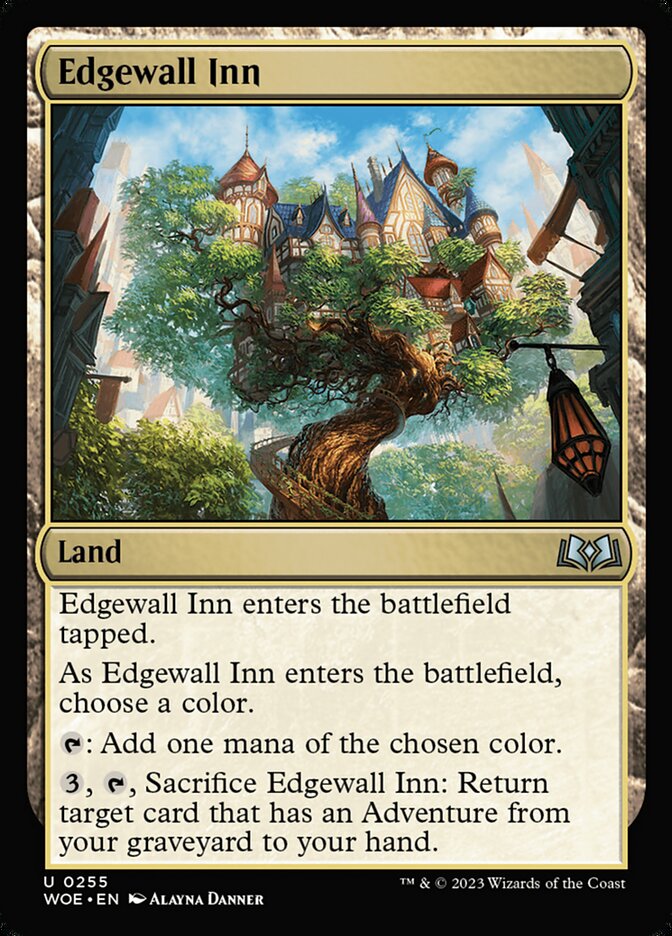
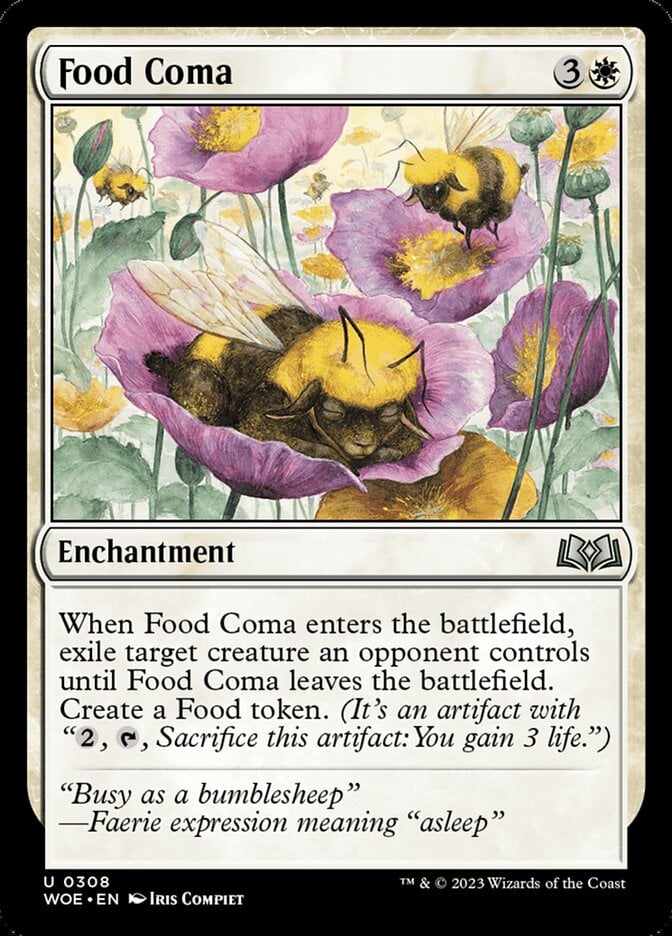
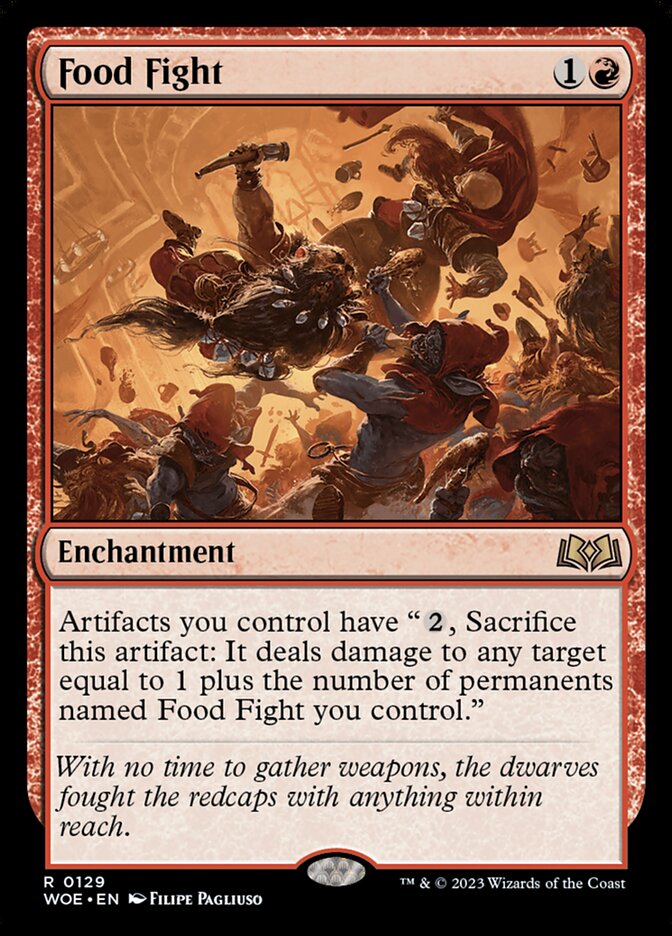
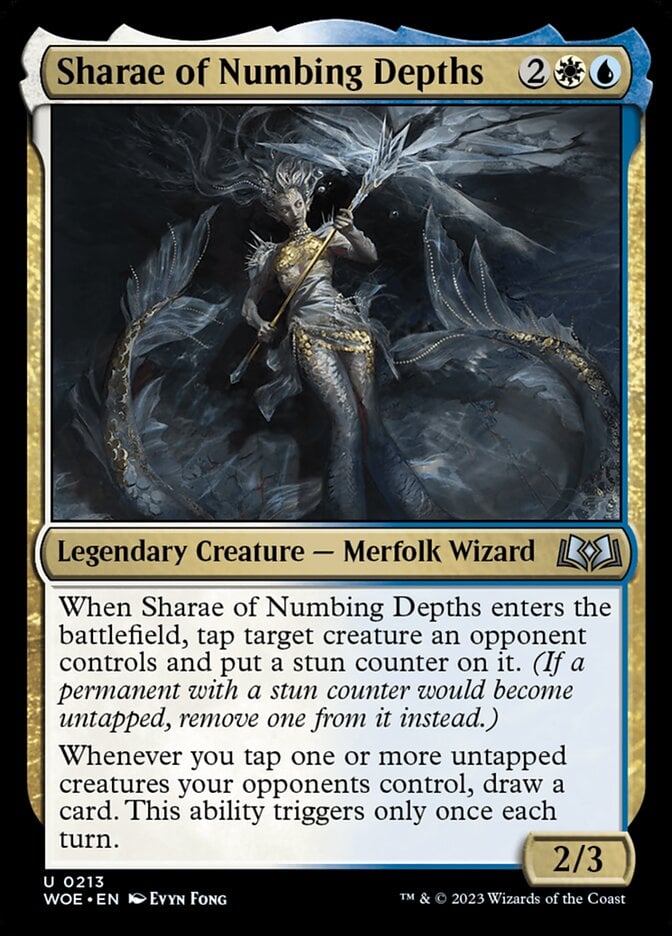
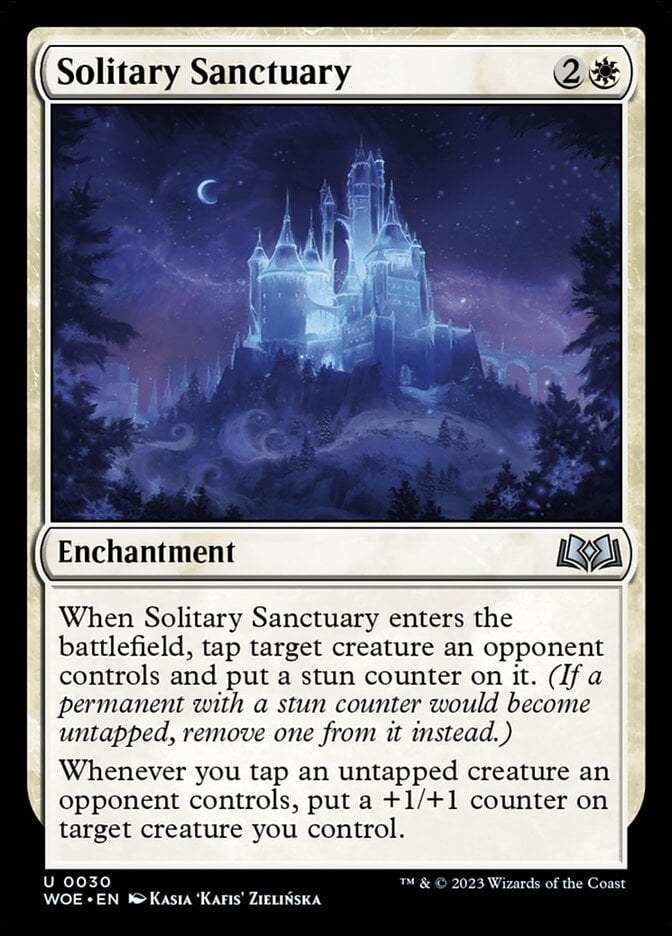

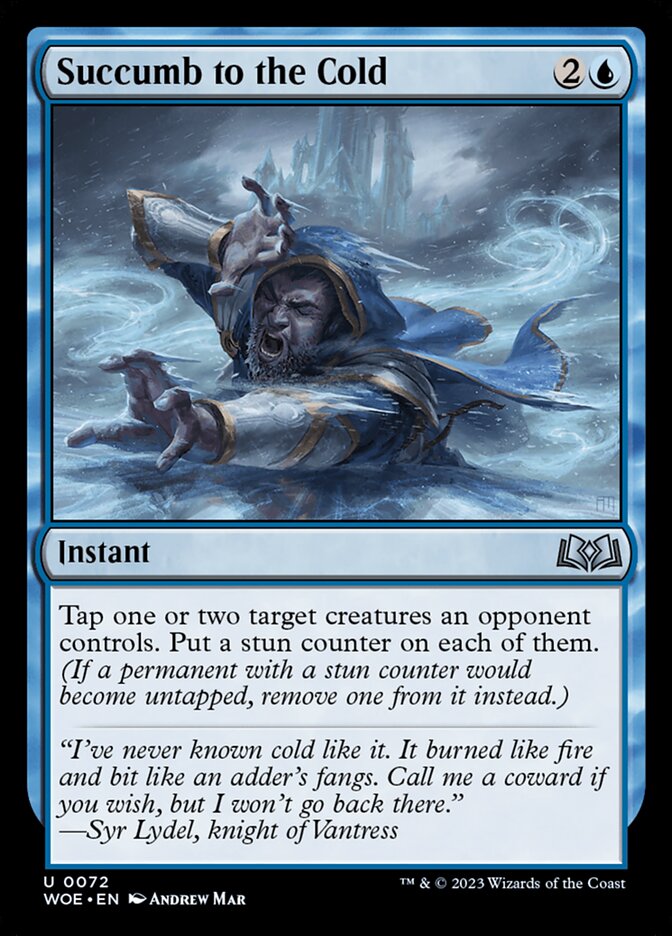



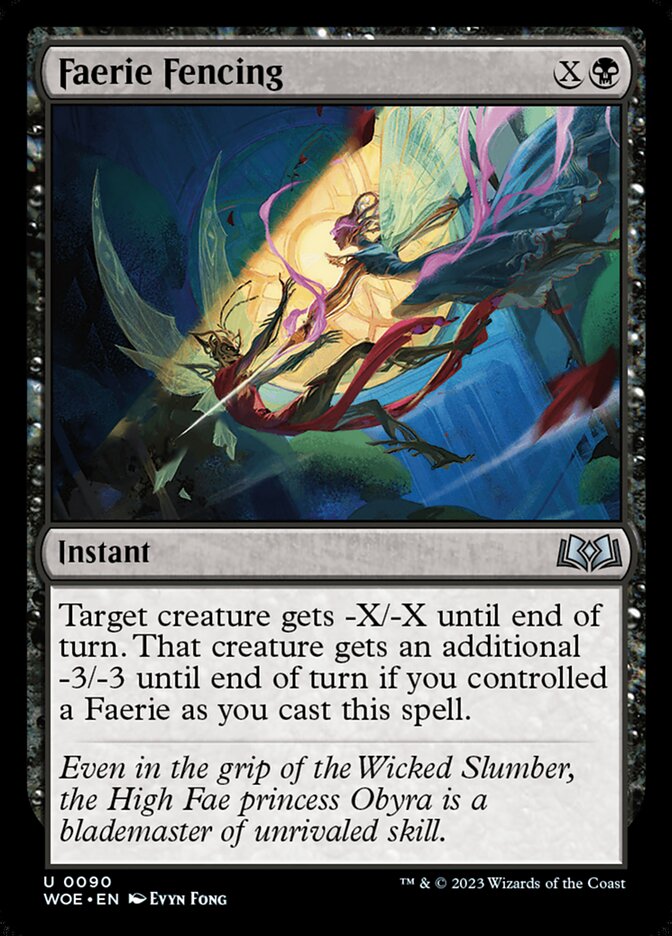

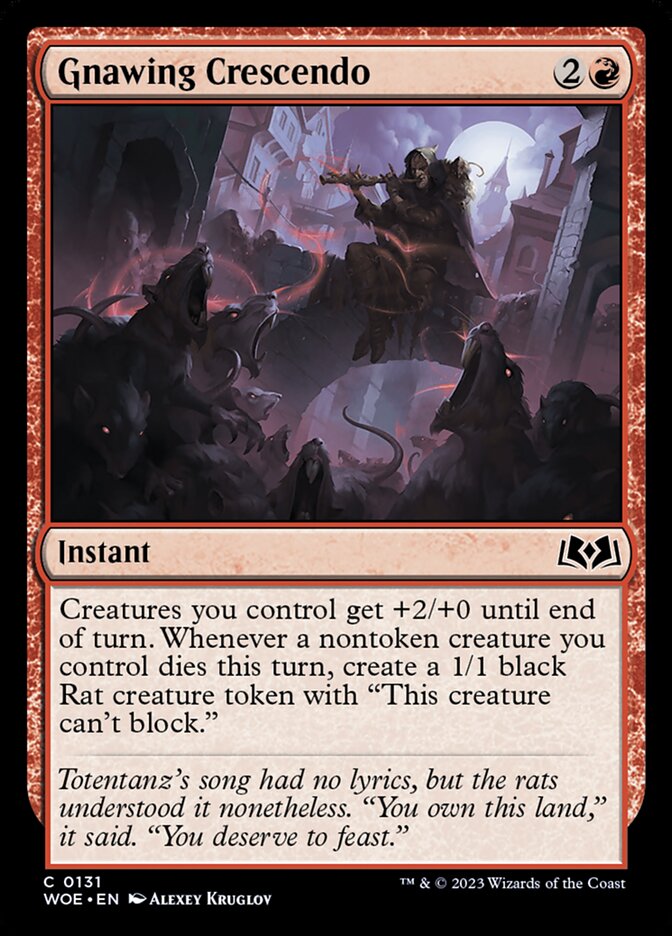
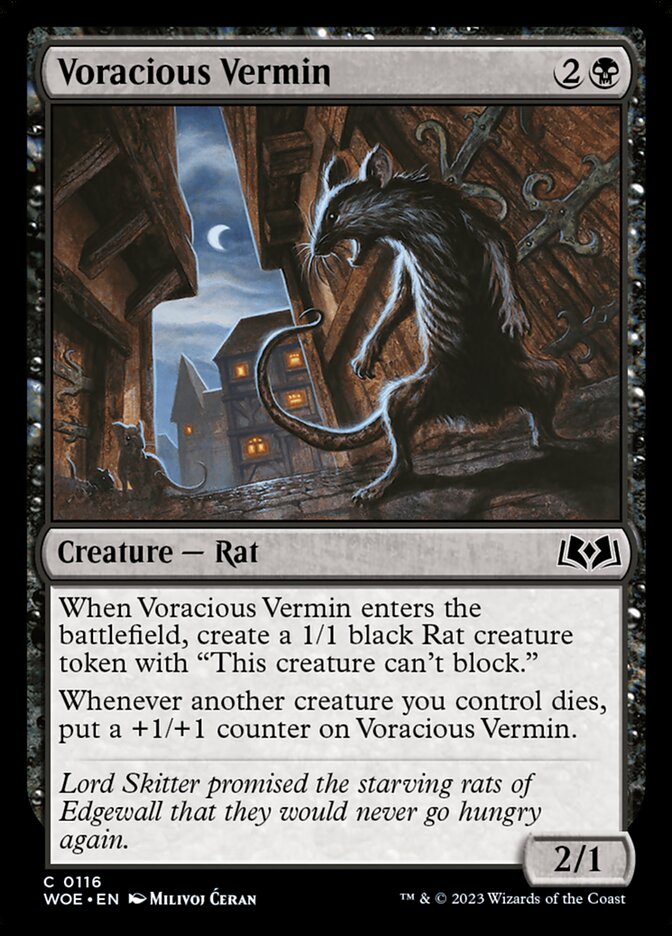

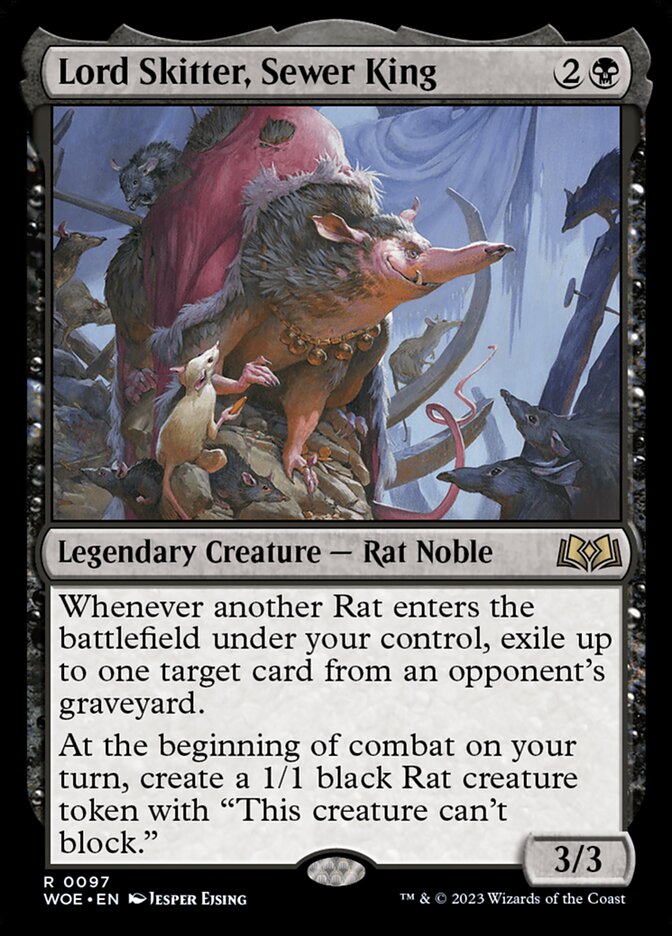


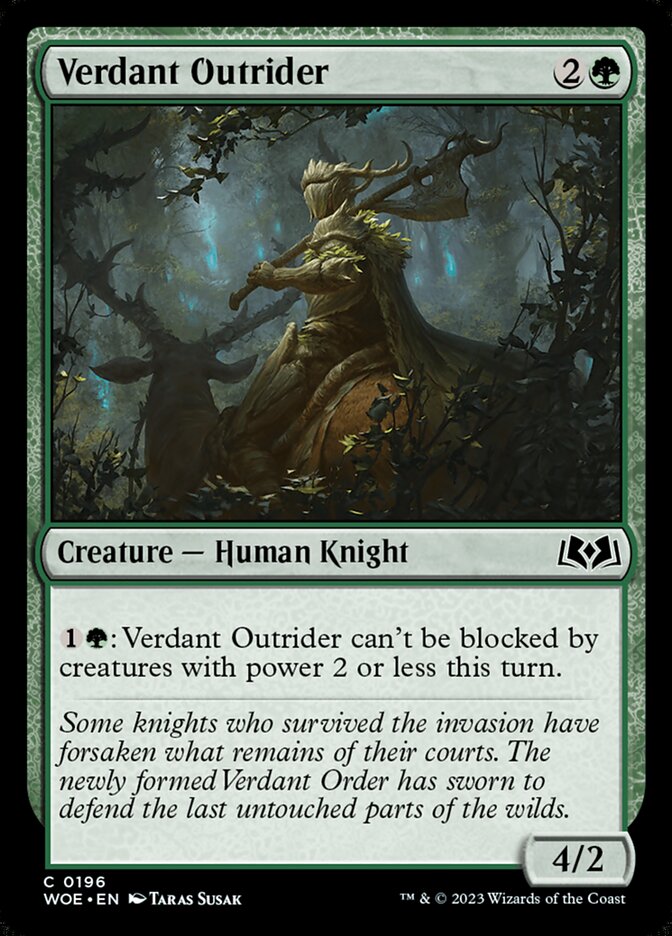
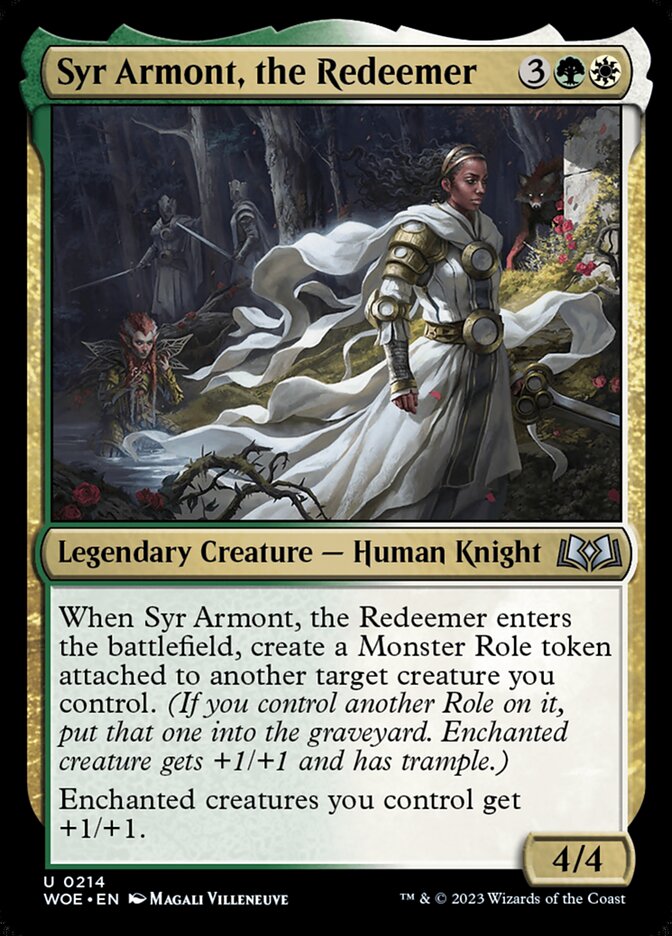
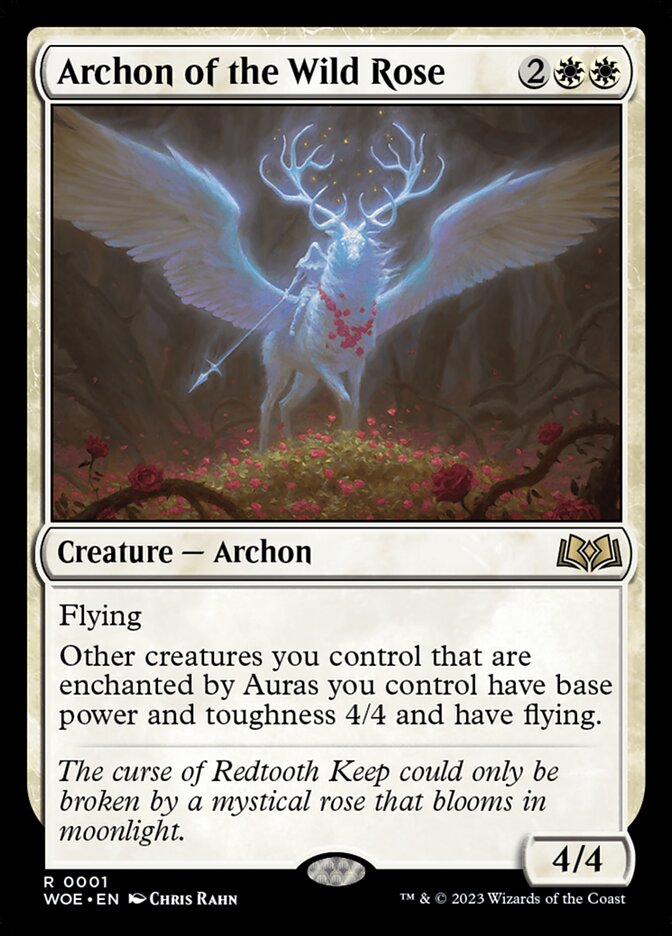
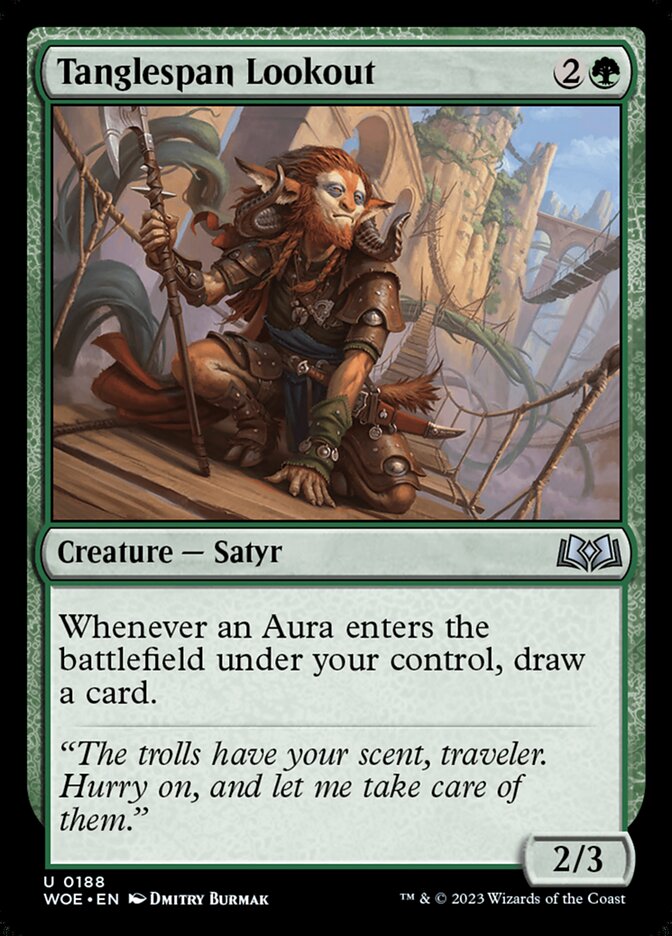
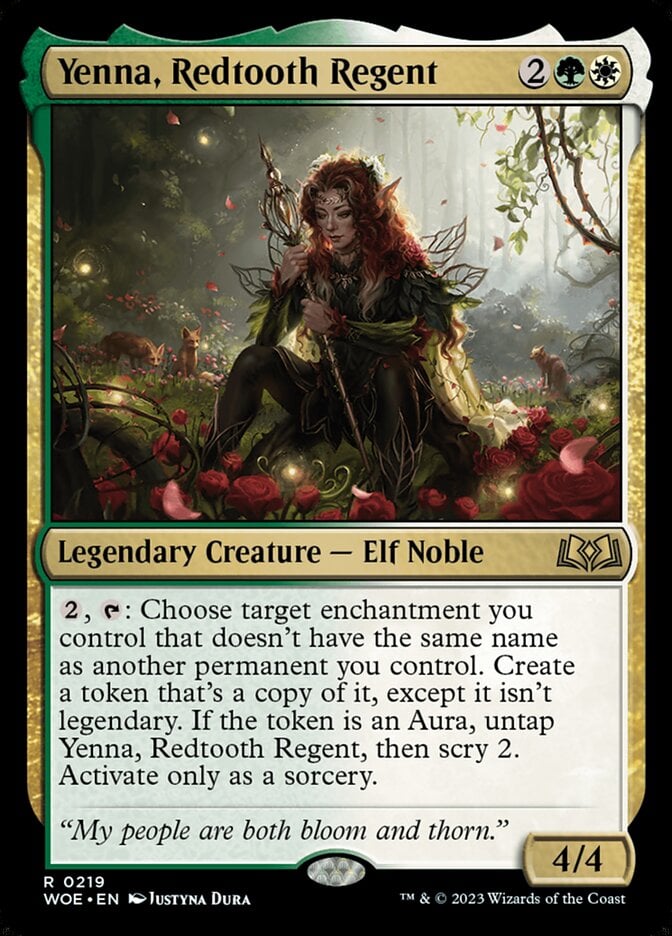


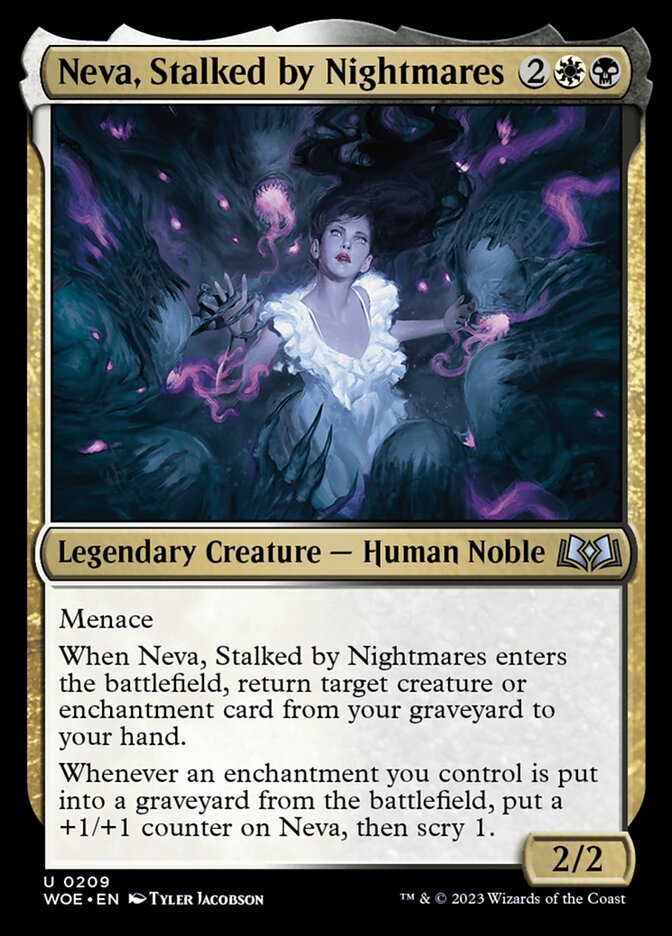
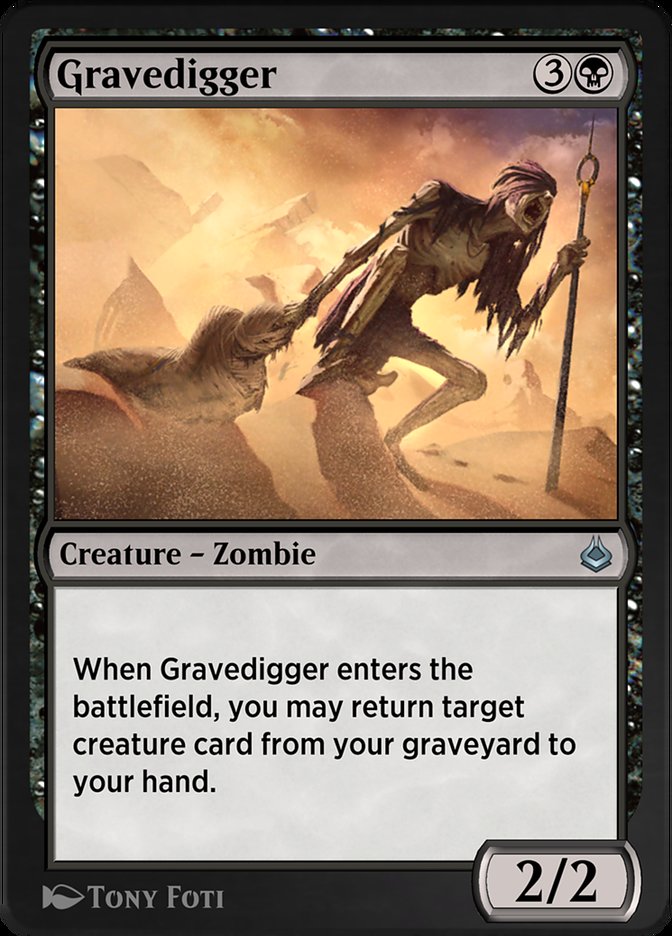
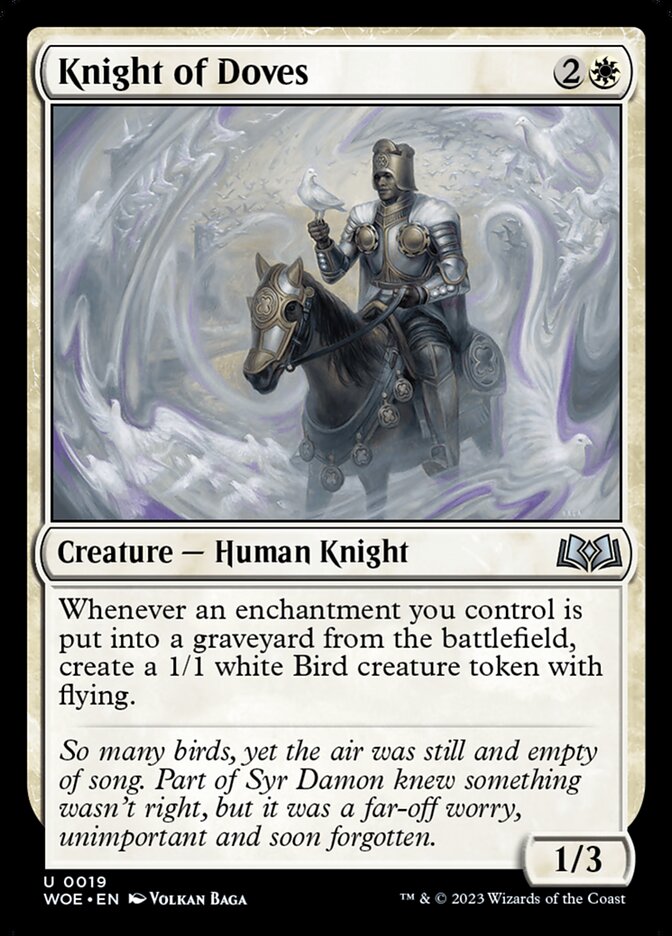
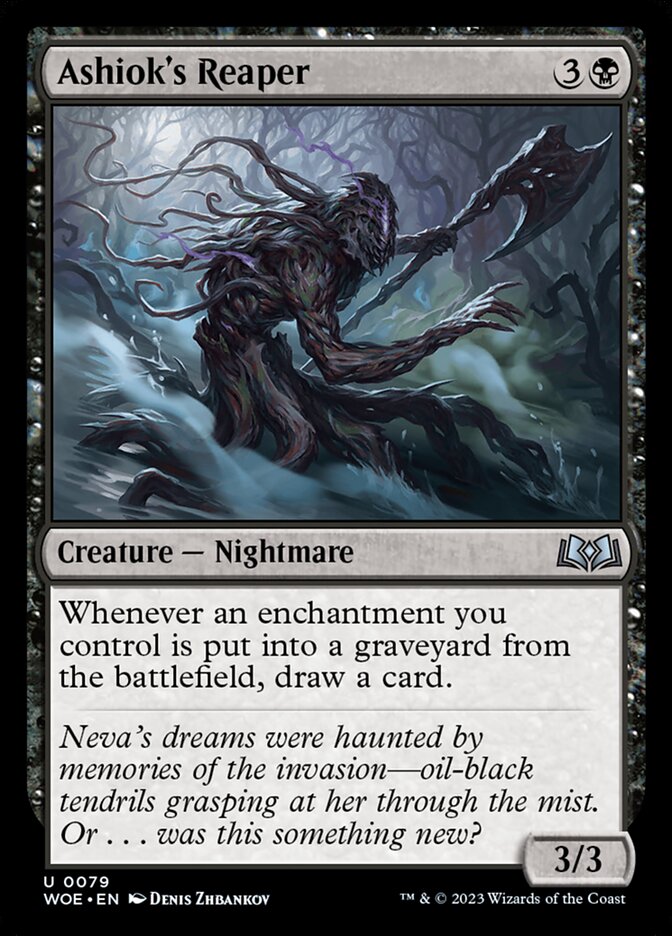
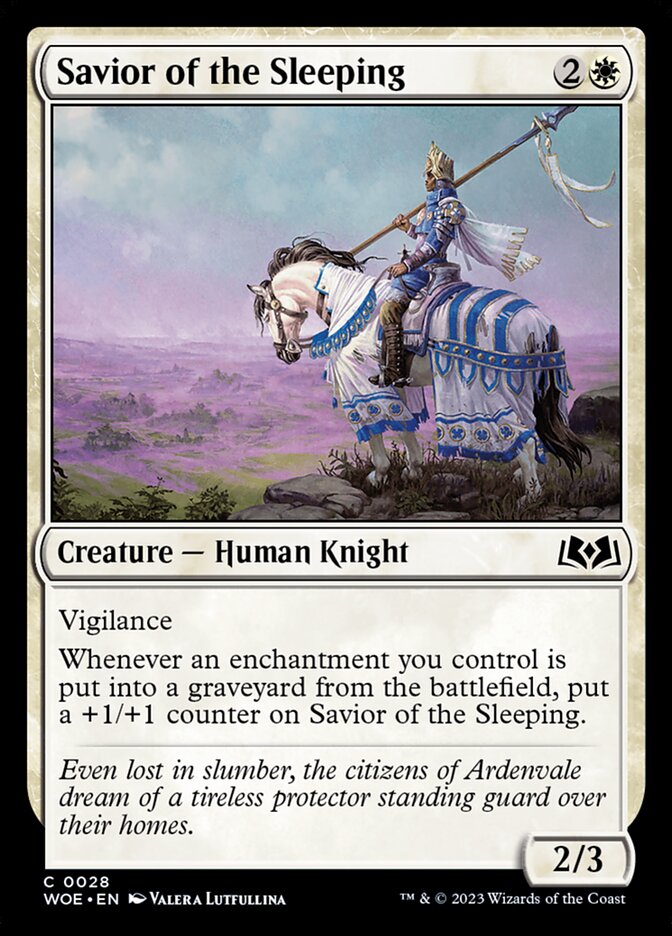
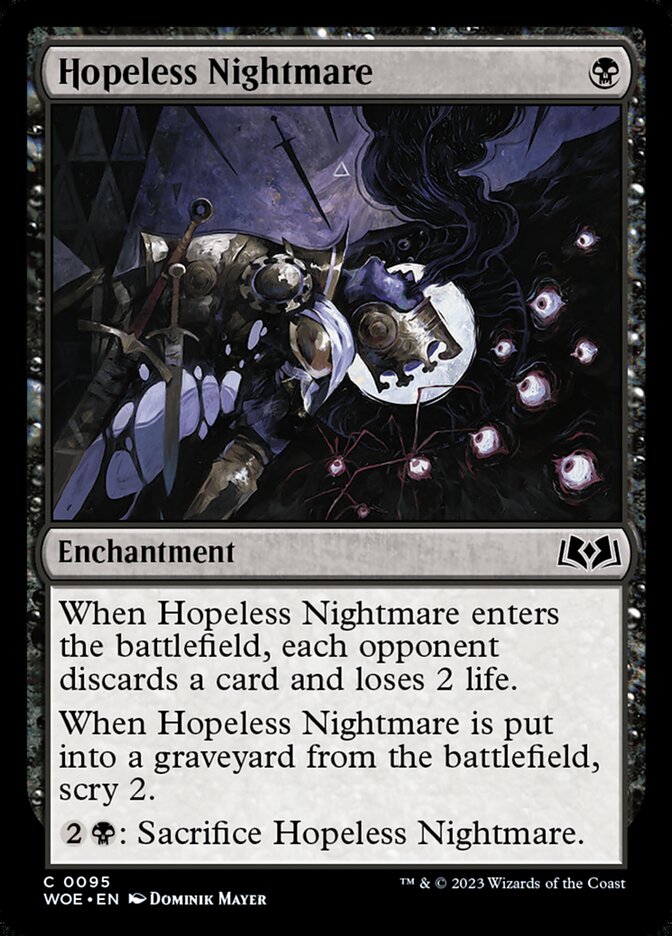

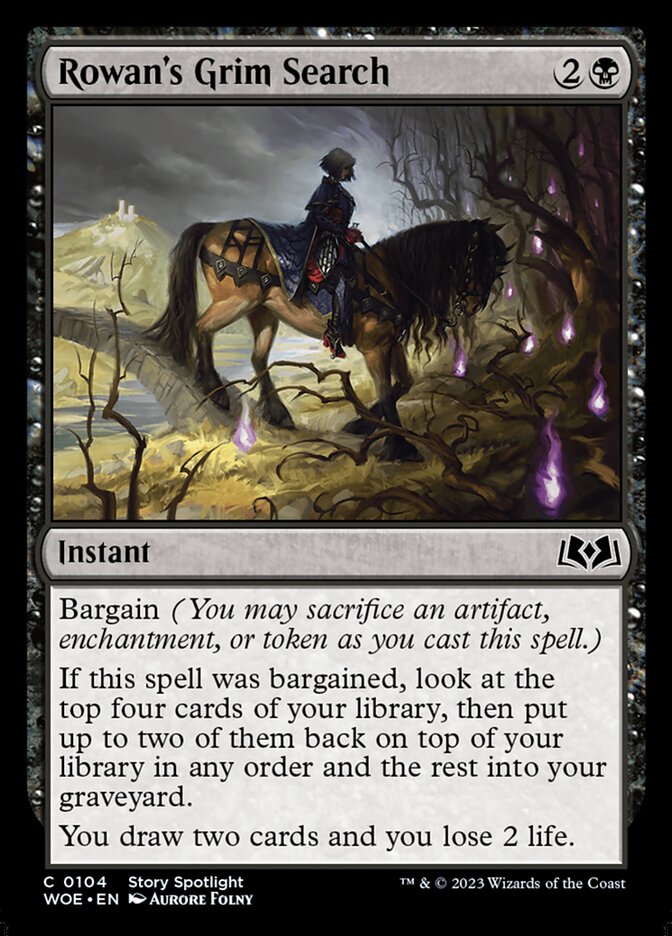
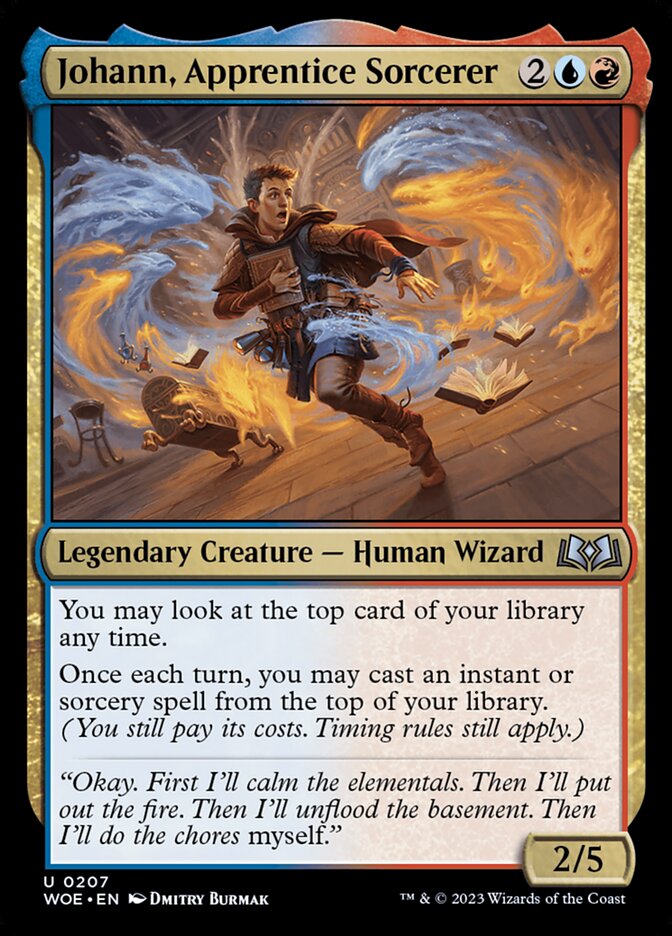


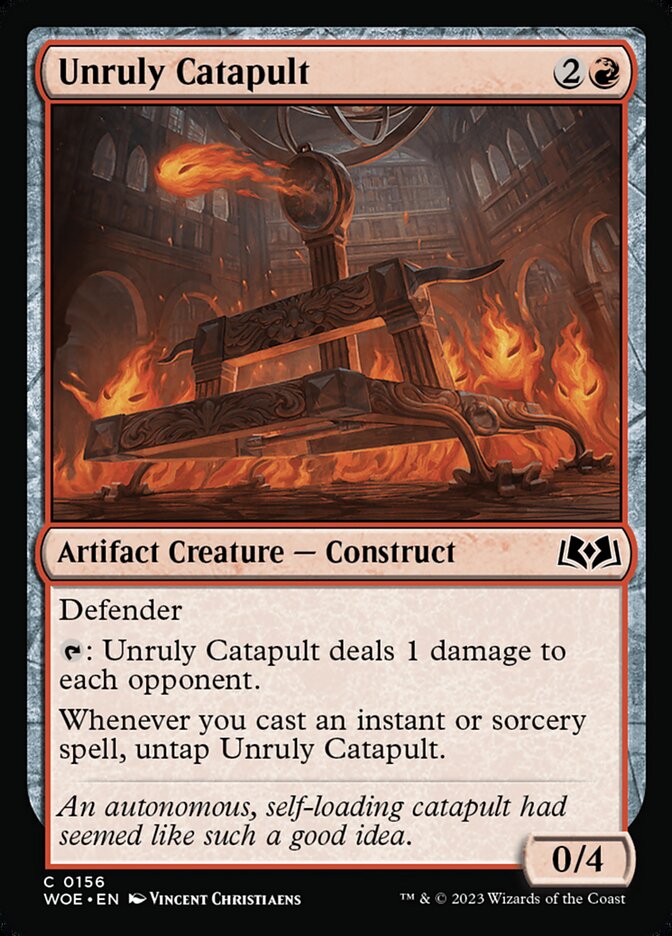
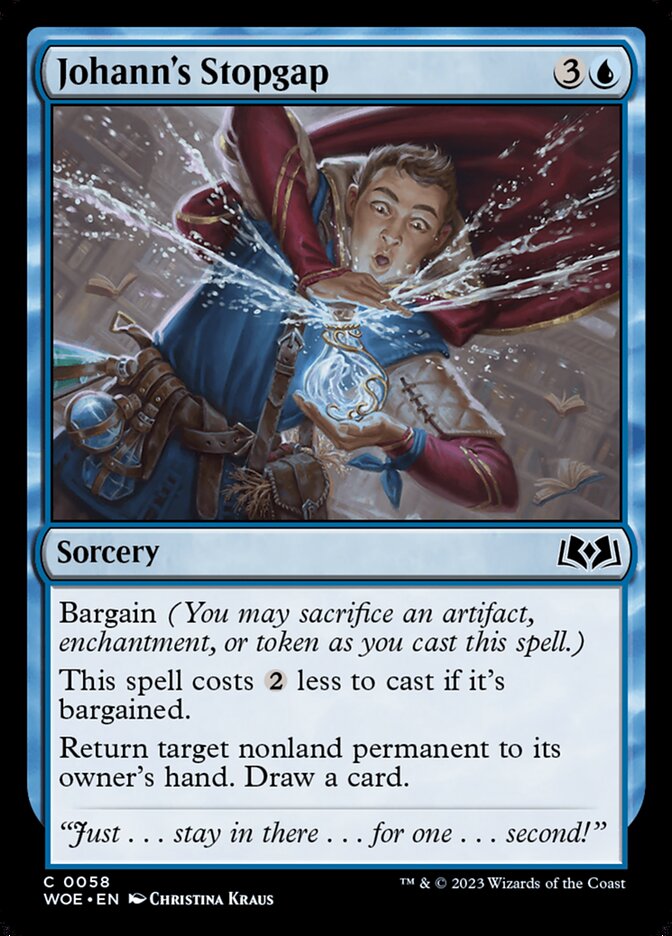
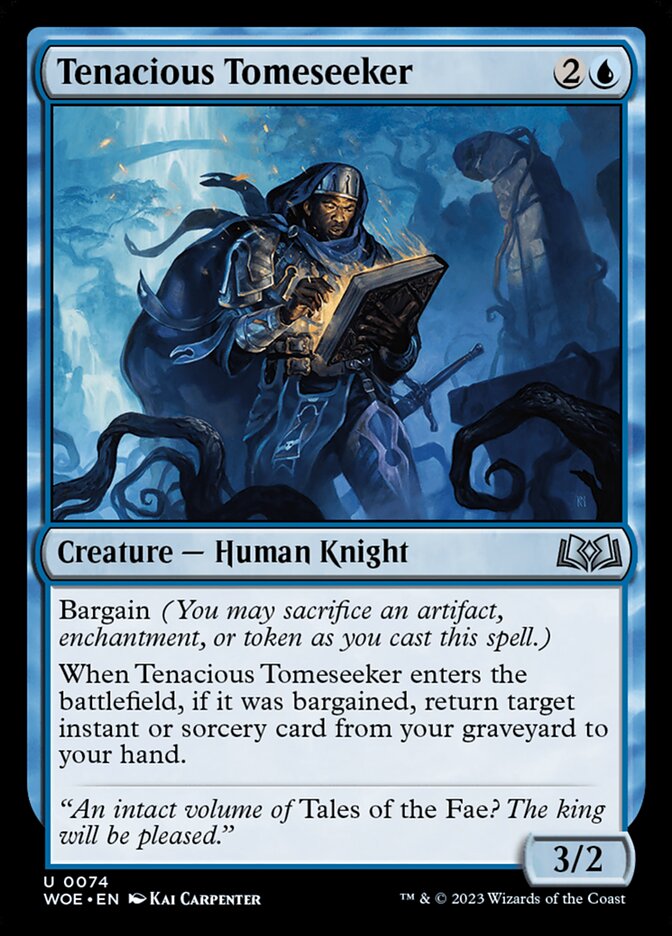
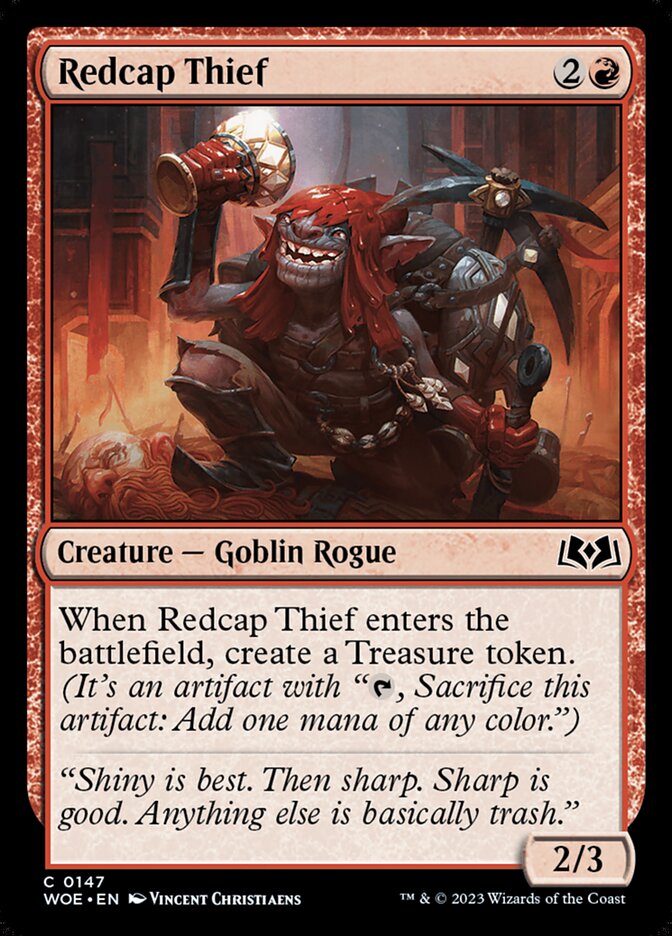
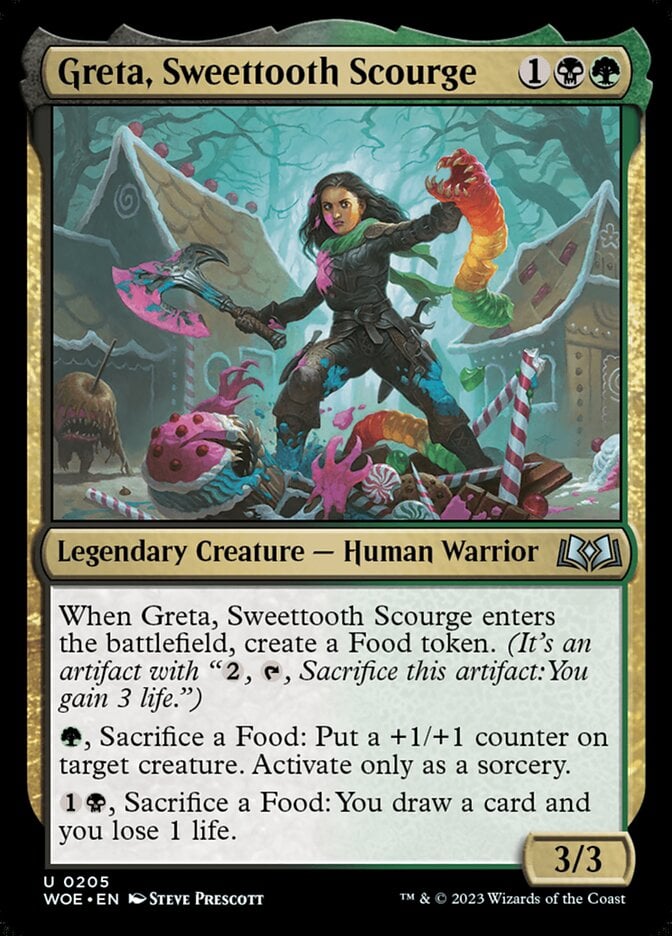
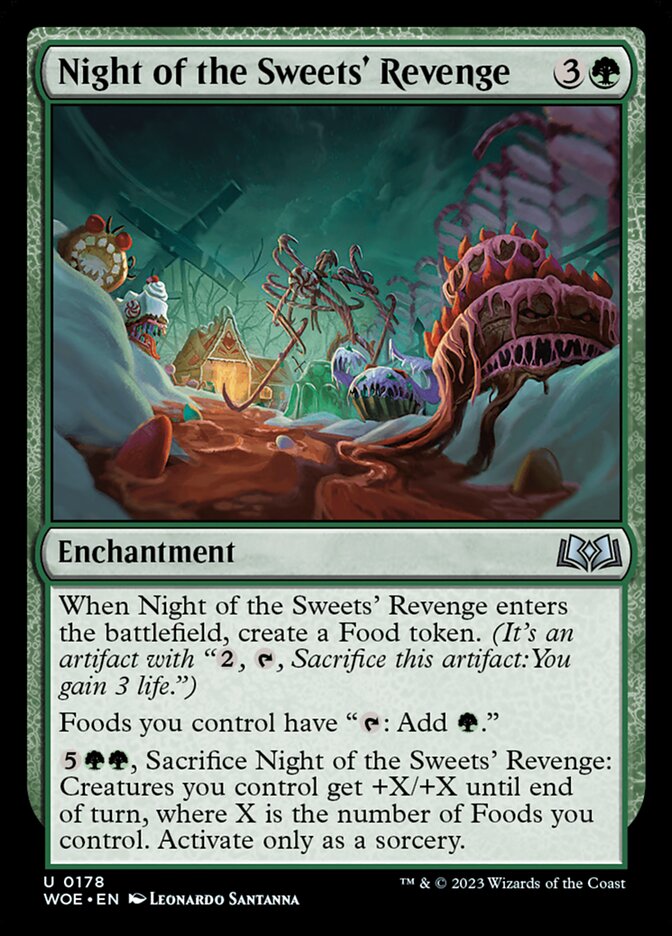
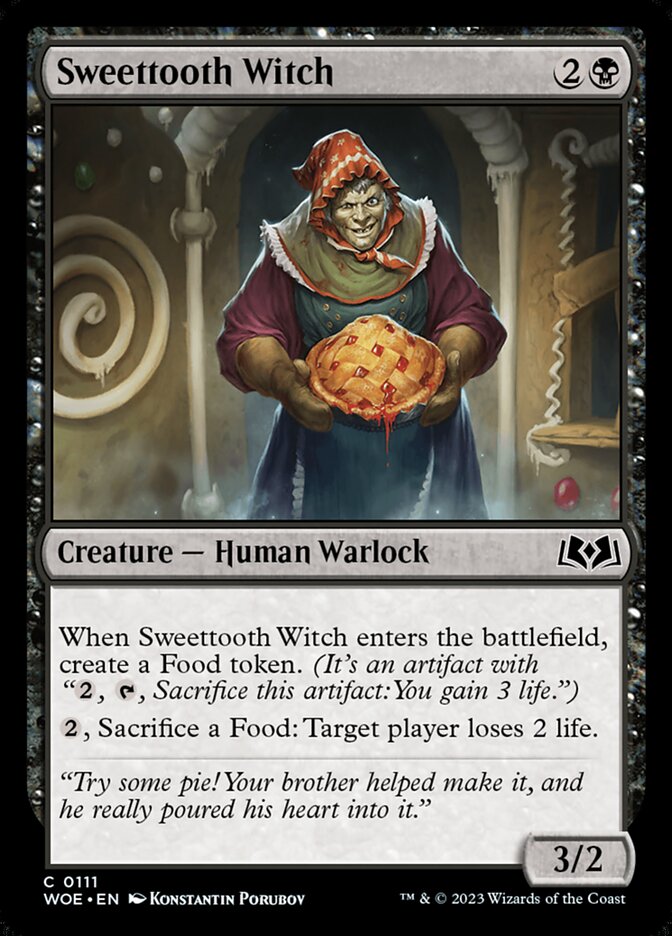
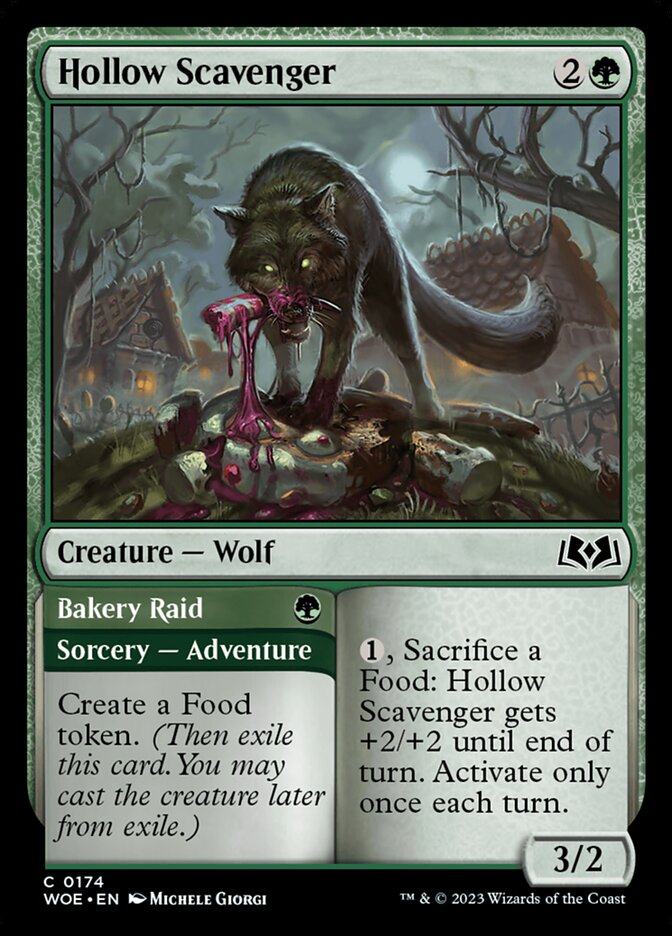
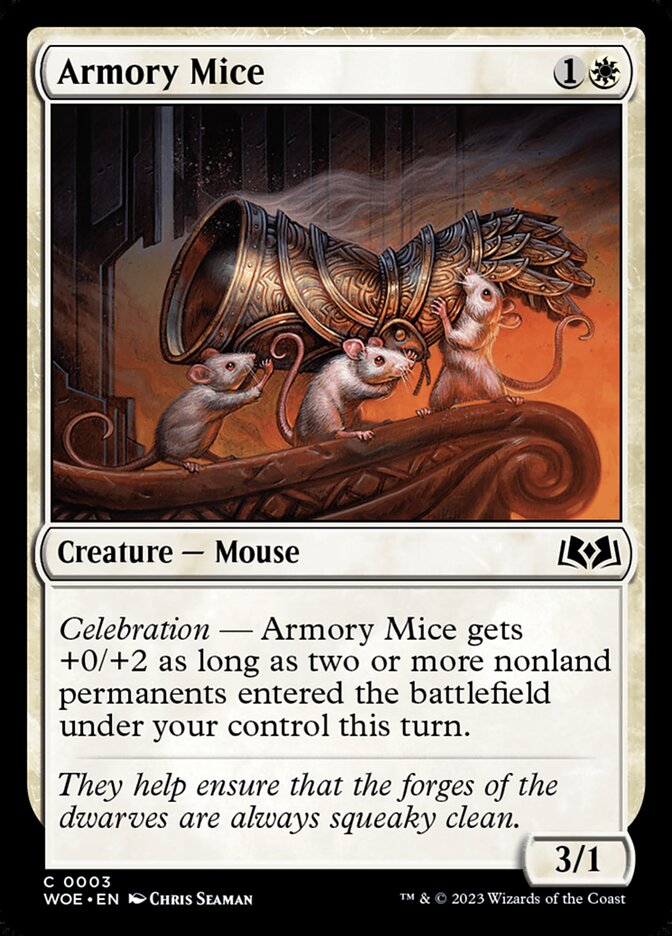
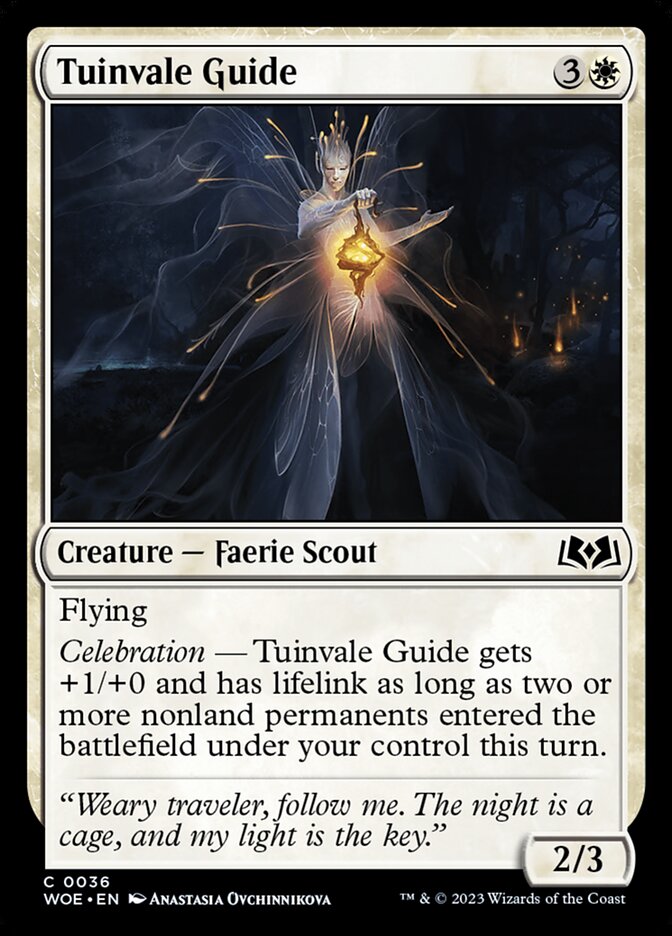
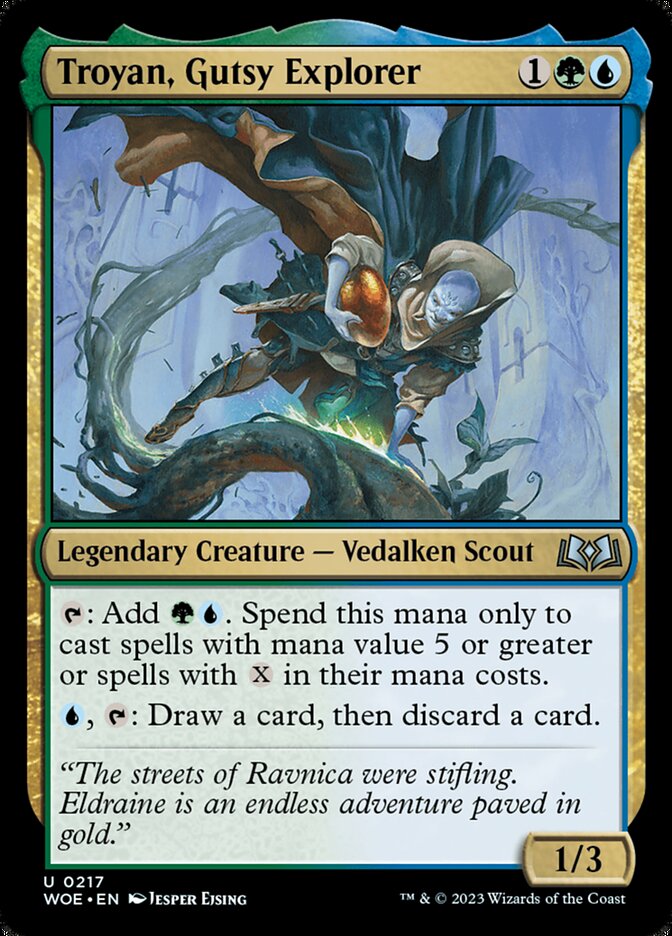

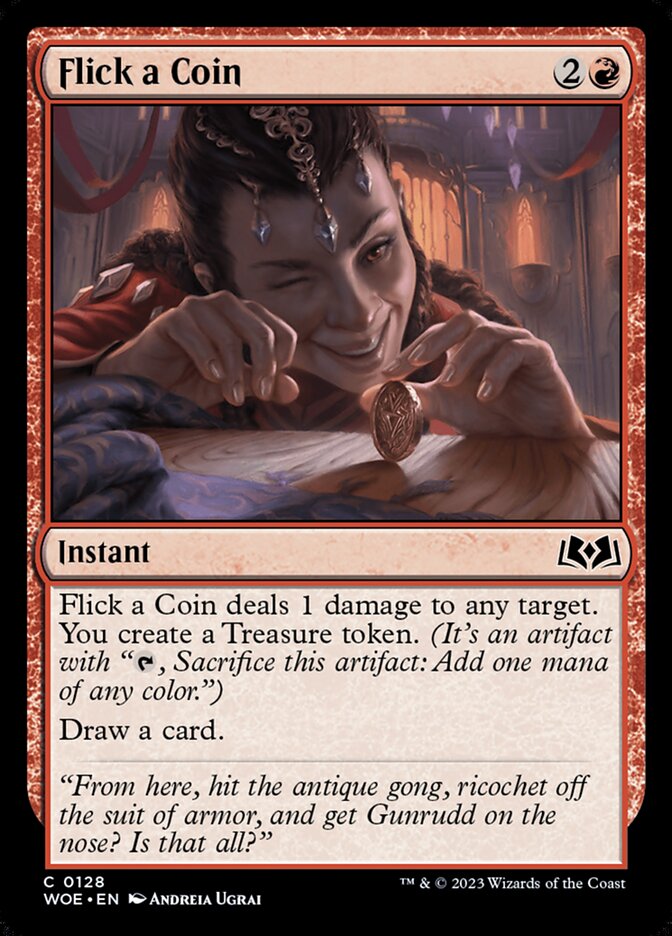
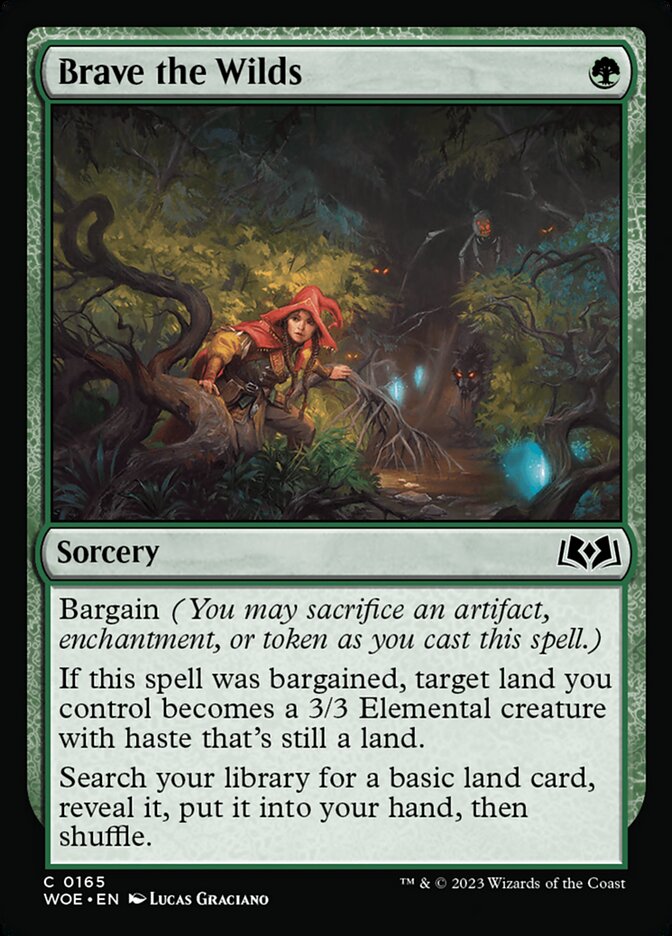
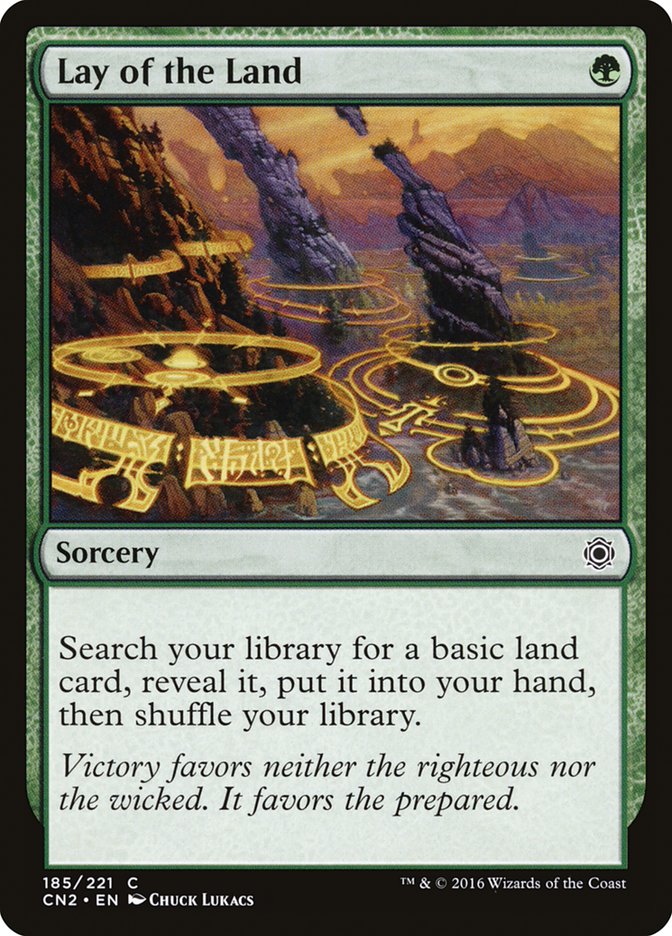

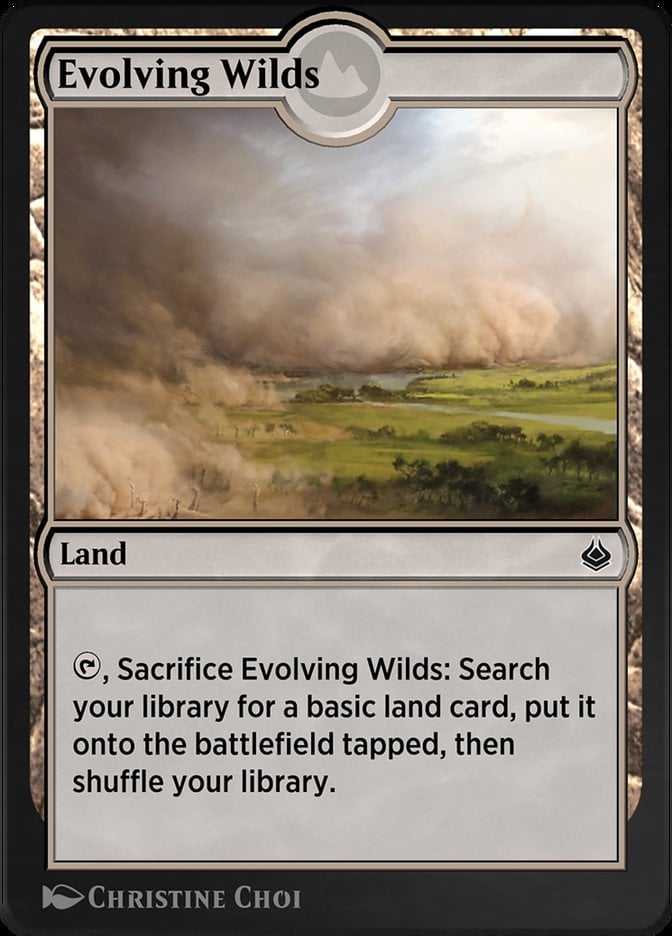
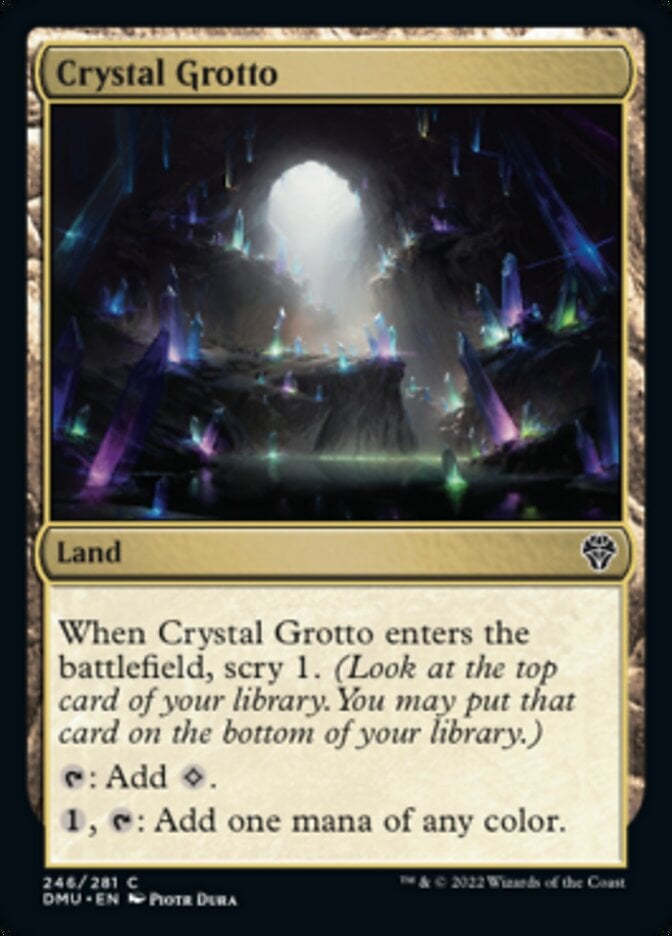


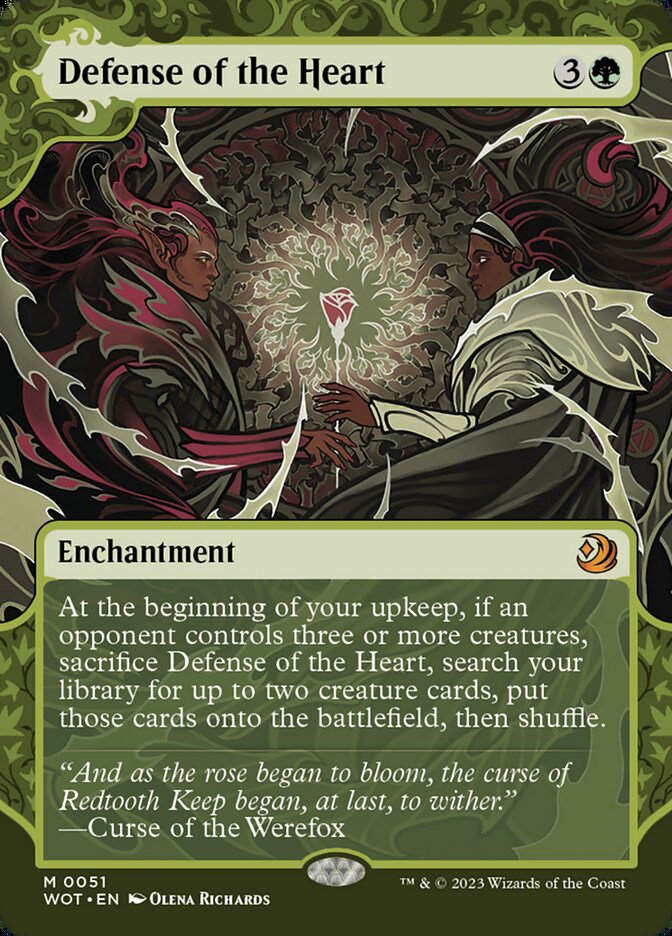
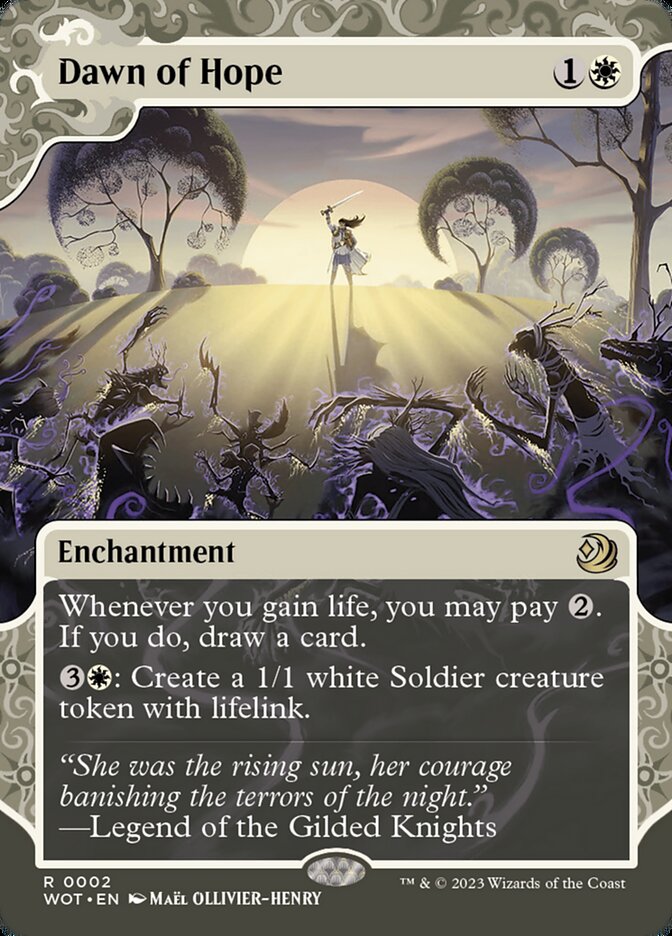
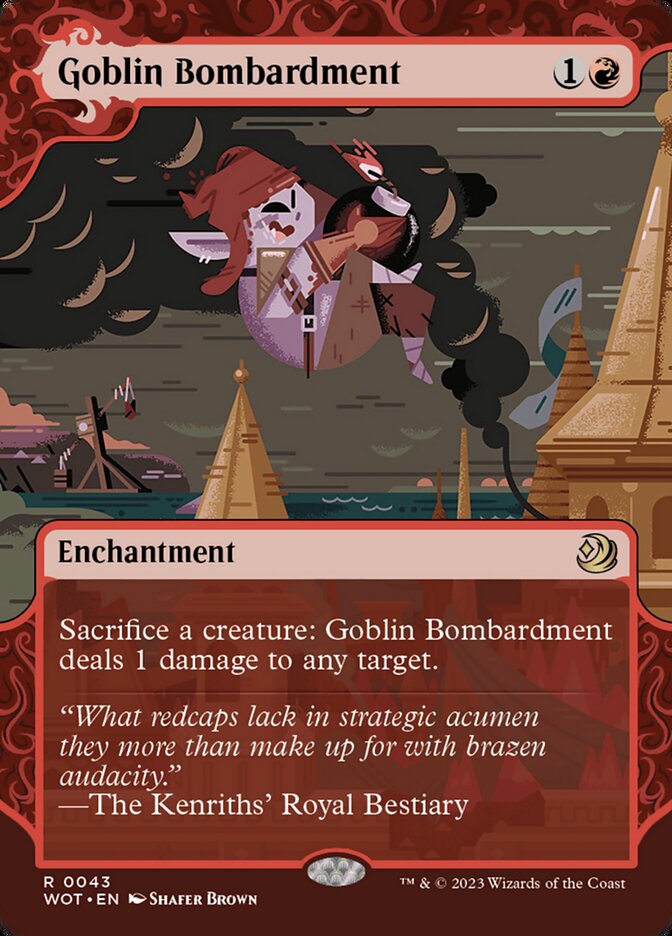
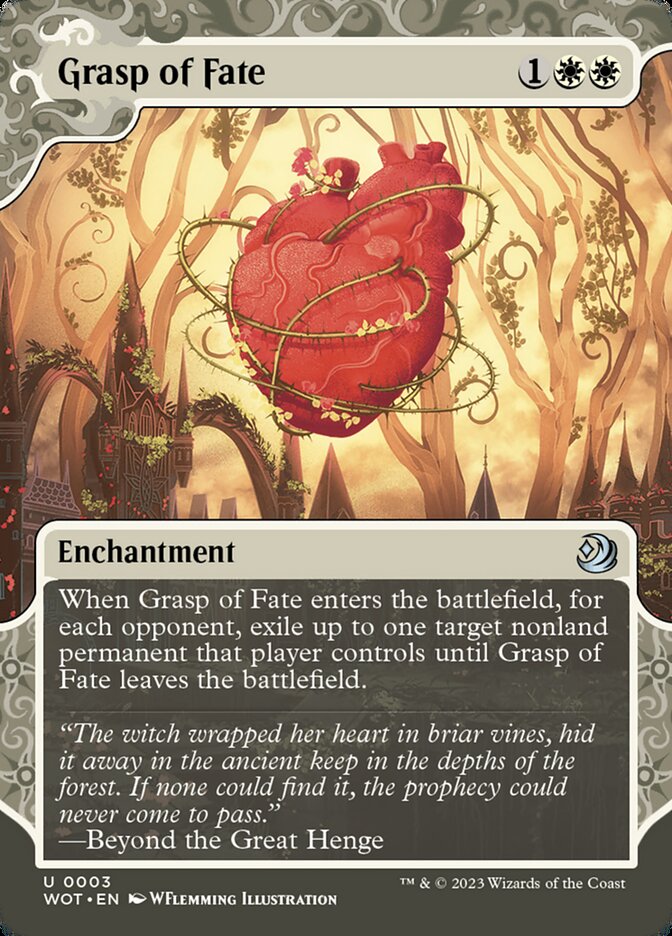
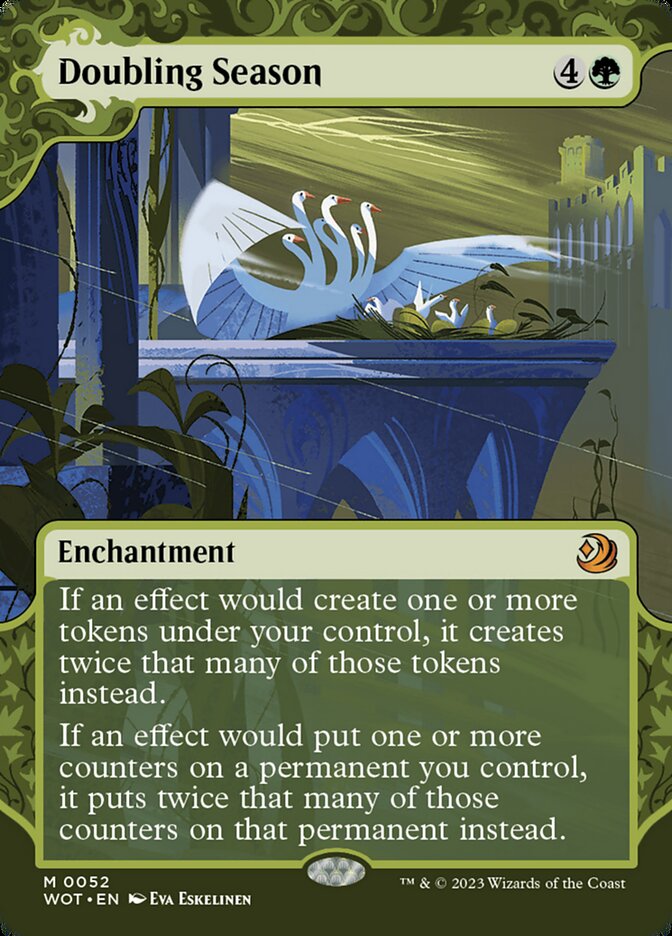
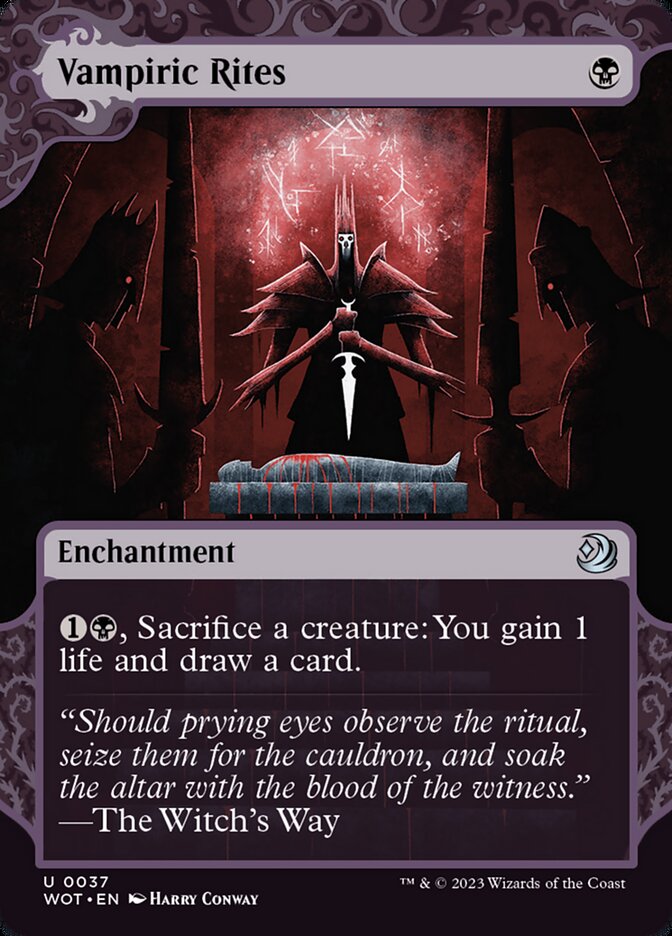
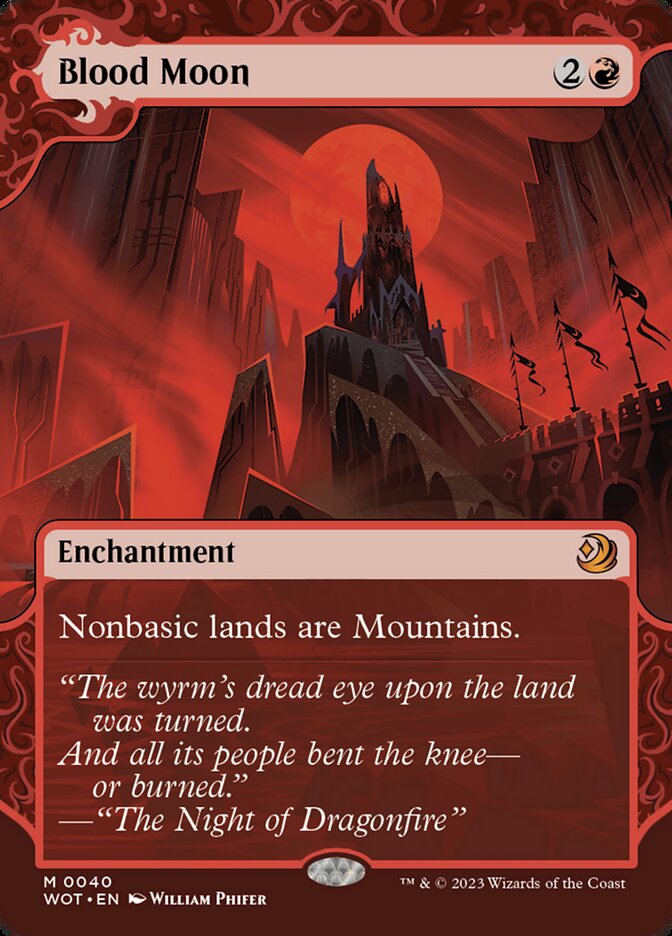
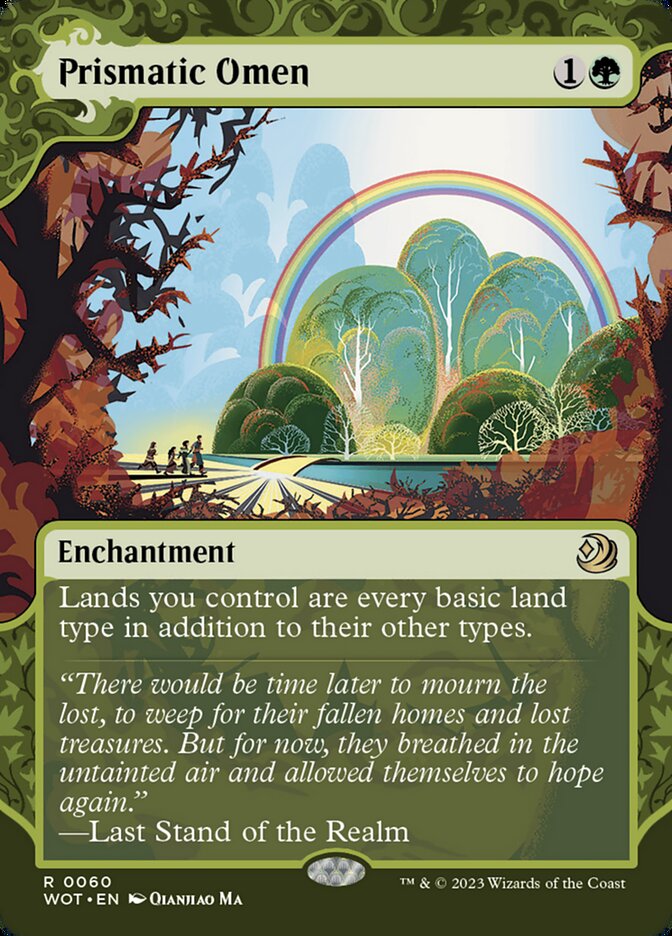
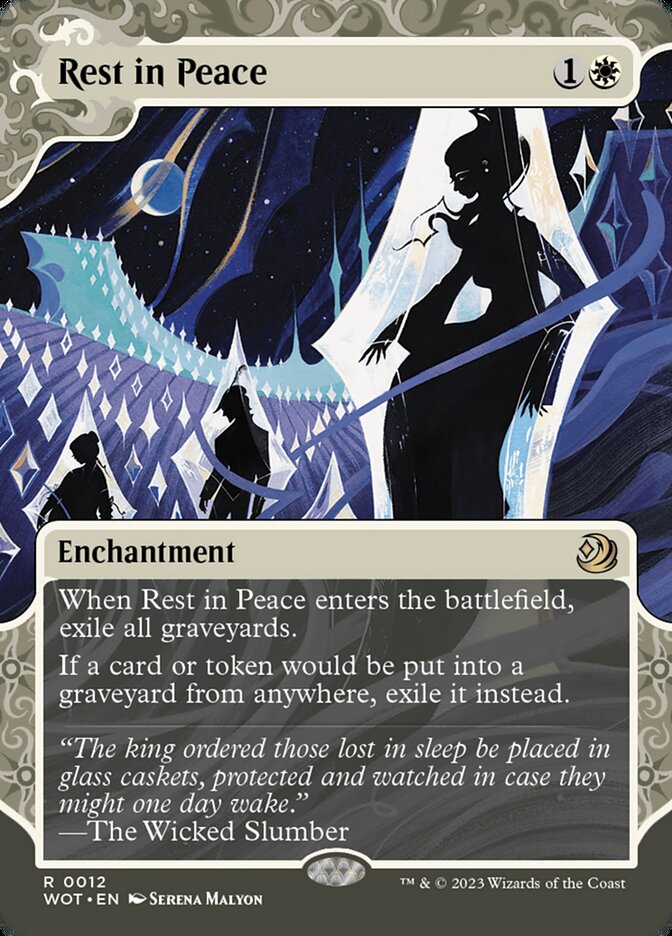
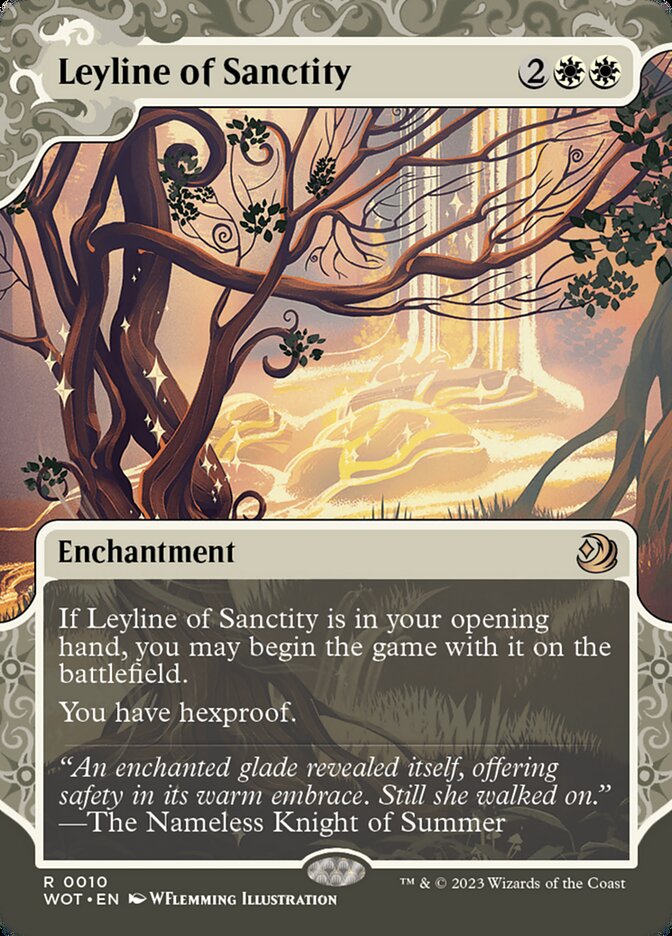

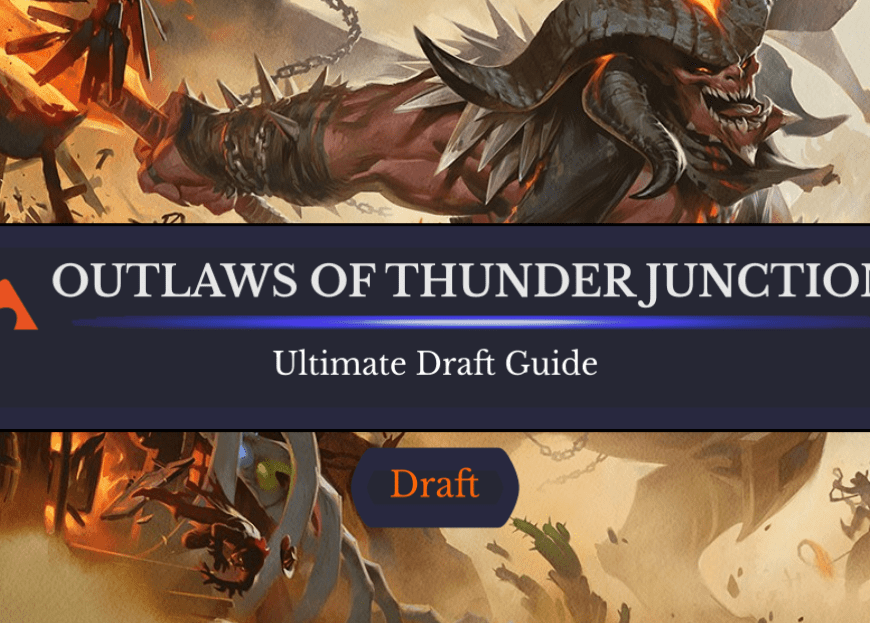
Add Comment